Unit 09 : Entrepreneurship & Small Business Management
VerifiedAdded on 2021/08/17
|27
|10477
|73
AI Summary
Contribute Materials
Your contribution can guide someone’s learning journey. Share your
documents today.

ASSIGNMENT 1 FRONT SHEET
Qualification BTEC Level 4 HND Diploma in Business
Unit number and title Unit 9: Entrepreneurship and Small Business Management
Submission date 02/04/2021 Date received (1 st submission) 01/04/2021
Re-submission date 06/04/2021 Date received (2 nd submission)
Student name Trần Lê Đức Quang Student ID GDB19108
Class GBD0803 Assessor name Badr Badra
Student declaration
I certify that the assignment submission is entirely my own work and I fully understand the consequences of plag
making a false declaration is a form of malpractice.
Student’s signature:
Trần Lê Đức Quang
Grading grid
P1 P2 P3 P4 M1 M2 D1
Qualification BTEC Level 4 HND Diploma in Business
Unit number and title Unit 9: Entrepreneurship and Small Business Management
Submission date 02/04/2021 Date received (1 st submission) 01/04/2021
Re-submission date 06/04/2021 Date received (2 nd submission)
Student name Trần Lê Đức Quang Student ID GDB19108
Class GBD0803 Assessor name Badr Badra
Student declaration
I certify that the assignment submission is entirely my own work and I fully understand the consequences of plag
making a false declaration is a form of malpractice.
Student’s signature:
Trần Lê Đức Quang
Grading grid
P1 P2 P3 P4 M1 M2 D1
Secure Best Marks with AI Grader
Need help grading? Try our AI Grader for instant feedback on your assignments.

2
Summative Feedbacks: Resubmission Feedbacks:
Grade: Assessor Signature: Date:
Internal Verifier’s Comments:
Signature & Date:
2.1
Summative Feedbacks: Resubmission Feedbacks:
Grade: Assessor Signature: Date:
Internal Verifier’s Comments:
Signature & Date:
2.1
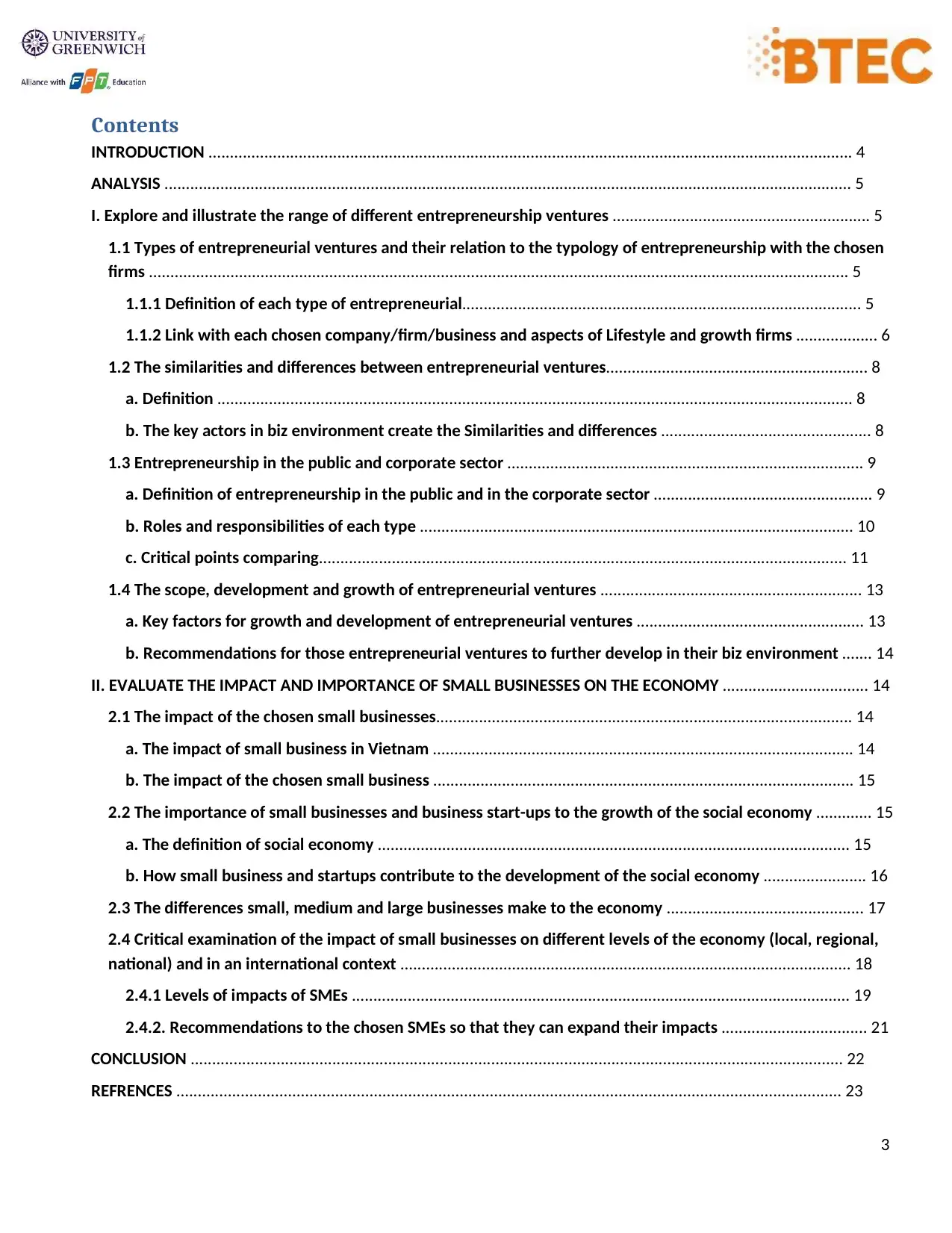
3
Contents
INTRODUCTION ...................................................................................................................................................... 4
ANALYSIS ................................................................................................................................................................ 5
I. Explore and illustrate the range of different entrepreneurship ventures ............................................................ 5
1.1 Types of entrepreneurial ventures and their relation to the typology of entrepreneurship with the chosen
firms ................................................................................................................................................................... 5
1.1.1 Definition of each type of entrepreneurial............................................................................................. 5
1.1.2 Link with each chosen company/firm/business and aspects of Lifestyle and growth firms ................... 6
1.2 The similarities and differences between entrepreneurial ventures............................................................. 8
a. Definition .................................................................................................................................................... 8
b. The key actors in biz environment create the Similarities and differences ................................................. 8
1.3 Entrepreneurship in the public and corporate sector ................................................................................... 9
a. Definition of entrepreneurship in the public and in the corporate sector ................................................... 9
b. Roles and responsibilities of each type ..................................................................................................... 10
c. Critical points comparing........................................................................................................................... 11
1.4 The scope, development and growth of entrepreneurial ventures ............................................................. 13
a. Key factors for growth and development of entrepreneurial ventures ..................................................... 13
b. Recommendations for those entrepreneurial ventures to further develop in their biz environment ....... 14
II. EVALUATE THE IMPACT AND IMPORTANCE OF SMALL BUSINESSES ON THE ECONOMY .................................. 14
2.1 The impact of the chosen small businesses................................................................................................. 14
a. The impact of small business in Vietnam .................................................................................................. 14
b. The impact of the chosen small business .................................................................................................. 15
2.2 The importance of small businesses and business start-ups to the growth of the social economy ............. 15
a. The definition of social economy .............................................................................................................. 15
b. How small business and startups contribute to the development of the social economy ........................ 16
2.3 The differences small, medium and large businesses make to the economy .............................................. 17
2.4 Critical examination of the impact of small businesses on different levels of the economy (local, regional,
national) and in an international context ......................................................................................................... 18
2.4.1 Levels of impacts of SMEs .................................................................................................................... 19
2.4.2. Recommendations to the chosen SMEs so that they can expand their impacts .................................. 21
CONCLUSION ........................................................................................................................................................ 22
REFRENCES ........................................................................................................................................................... 23
Contents
INTRODUCTION ...................................................................................................................................................... 4
ANALYSIS ................................................................................................................................................................ 5
I. Explore and illustrate the range of different entrepreneurship ventures ............................................................ 5
1.1 Types of entrepreneurial ventures and their relation to the typology of entrepreneurship with the chosen
firms ................................................................................................................................................................... 5
1.1.1 Definition of each type of entrepreneurial............................................................................................. 5
1.1.2 Link with each chosen company/firm/business and aspects of Lifestyle and growth firms ................... 6
1.2 The similarities and differences between entrepreneurial ventures............................................................. 8
a. Definition .................................................................................................................................................... 8
b. The key actors in biz environment create the Similarities and differences ................................................. 8
1.3 Entrepreneurship in the public and corporate sector ................................................................................... 9
a. Definition of entrepreneurship in the public and in the corporate sector ................................................... 9
b. Roles and responsibilities of each type ..................................................................................................... 10
c. Critical points comparing........................................................................................................................... 11
1.4 The scope, development and growth of entrepreneurial ventures ............................................................. 13
a. Key factors for growth and development of entrepreneurial ventures ..................................................... 13
b. Recommendations for those entrepreneurial ventures to further develop in their biz environment ....... 14
II. EVALUATE THE IMPACT AND IMPORTANCE OF SMALL BUSINESSES ON THE ECONOMY .................................. 14
2.1 The impact of the chosen small businesses................................................................................................. 14
a. The impact of small business in Vietnam .................................................................................................. 14
b. The impact of the chosen small business .................................................................................................. 15
2.2 The importance of small businesses and business start-ups to the growth of the social economy ............. 15
a. The definition of social economy .............................................................................................................. 15
b. How small business and startups contribute to the development of the social economy ........................ 16
2.3 The differences small, medium and large businesses make to the economy .............................................. 17
2.4 Critical examination of the impact of small businesses on different levels of the economy (local, regional,
national) and in an international context ......................................................................................................... 18
2.4.1 Levels of impacts of SMEs .................................................................................................................... 19
2.4.2. Recommendations to the chosen SMEs so that they can expand their impacts .................................. 21
CONCLUSION ........................................................................................................................................................ 22
REFRENCES ........................................................................................................................................................... 23
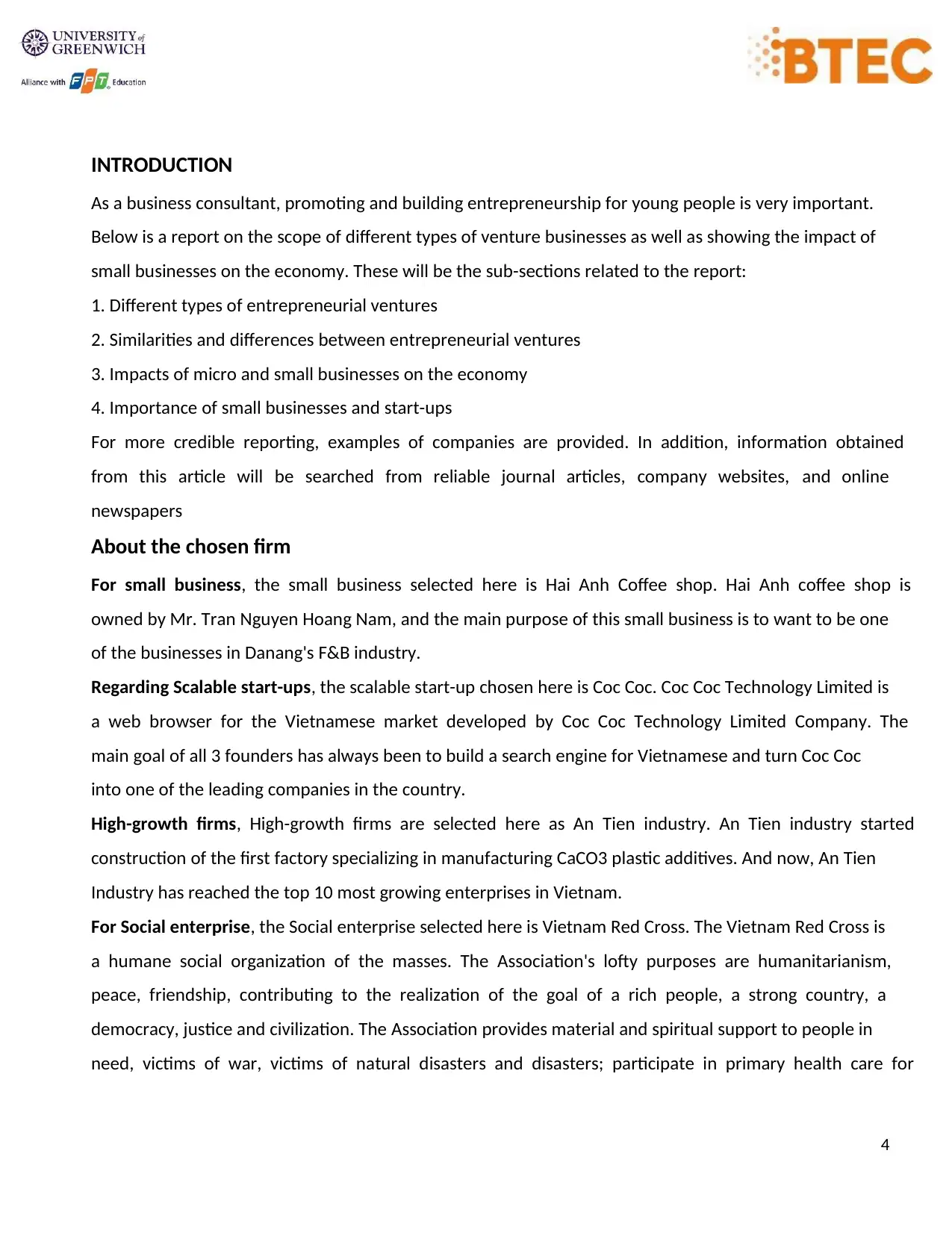
4
INTRODUCTION
As a business consultant, promoting and building entrepreneurship for young people is very important.
Below is a report on the scope of different types of venture businesses as well as showing the impact of
small businesses on the economy. These will be the sub-sections related to the report:
1. Different types of entrepreneurial ventures
2. Similarities and differences between entrepreneurial ventures
3. Impacts of micro and small businesses on the economy
4. Importance of small businesses and start-ups
For more credible reporting, examples of companies are provided. In addition, information obtained
from this article will be searched from reliable journal articles, company websites, and online
newspapers
About the chosen firm
For small business, the small business selected here is Hai Anh Coffee shop. Hai Anh coffee shop is
owned by Mr. Tran Nguyen Hoang Nam, and the main purpose of this small business is to want to be one
of the businesses in Danang's F&B industry.
Regarding Scalable start-ups, the scalable start-up chosen here is Coc Coc. Coc Coc Technology Limited is
a web browser for the Vietnamese market developed by Coc Coc Technology Limited Company. The
main goal of all 3 founders has always been to build a search engine for Vietnamese and turn Coc Coc
into one of the leading companies in the country.
High-growth firms, High-growth firms are selected here as An Tien industry. An Tien industry started
construction of the first factory specializing in manufacturing CaCO3 plastic additives. And now, An Tien
Industry has reached the top 10 most growing enterprises in Vietnam.
For Social enterprise, the Social enterprise selected here is Vietnam Red Cross. The Vietnam Red Cross is
a humane social organization of the masses. The Association's lofty purposes are humanitarianism,
peace, friendship, contributing to the realization of the goal of a rich people, a strong country, a
democracy, justice and civilization. The Association provides material and spiritual support to people in
need, victims of war, victims of natural disasters and disasters; participate in primary health care for
INTRODUCTION
As a business consultant, promoting and building entrepreneurship for young people is very important.
Below is a report on the scope of different types of venture businesses as well as showing the impact of
small businesses on the economy. These will be the sub-sections related to the report:
1. Different types of entrepreneurial ventures
2. Similarities and differences between entrepreneurial ventures
3. Impacts of micro and small businesses on the economy
4. Importance of small businesses and start-ups
For more credible reporting, examples of companies are provided. In addition, information obtained
from this article will be searched from reliable journal articles, company websites, and online
newspapers
About the chosen firm
For small business, the small business selected here is Hai Anh Coffee shop. Hai Anh coffee shop is
owned by Mr. Tran Nguyen Hoang Nam, and the main purpose of this small business is to want to be one
of the businesses in Danang's F&B industry.
Regarding Scalable start-ups, the scalable start-up chosen here is Coc Coc. Coc Coc Technology Limited is
a web browser for the Vietnamese market developed by Coc Coc Technology Limited Company. The
main goal of all 3 founders has always been to build a search engine for Vietnamese and turn Coc Coc
into one of the leading companies in the country.
High-growth firms, High-growth firms are selected here as An Tien industry. An Tien industry started
construction of the first factory specializing in manufacturing CaCO3 plastic additives. And now, An Tien
Industry has reached the top 10 most growing enterprises in Vietnam.
For Social enterprise, the Social enterprise selected here is Vietnam Red Cross. The Vietnam Red Cross is
a humane social organization of the masses. The Association's lofty purposes are humanitarianism,
peace, friendship, contributing to the realization of the goal of a rich people, a strong country, a
democracy, justice and civilization. The Association provides material and spiritual support to people in
need, victims of war, victims of natural disasters and disasters; participate in primary health care for
Secure Best Marks with AI Grader
Need help grading? Try our AI Grader for instant feedback on your assignments.
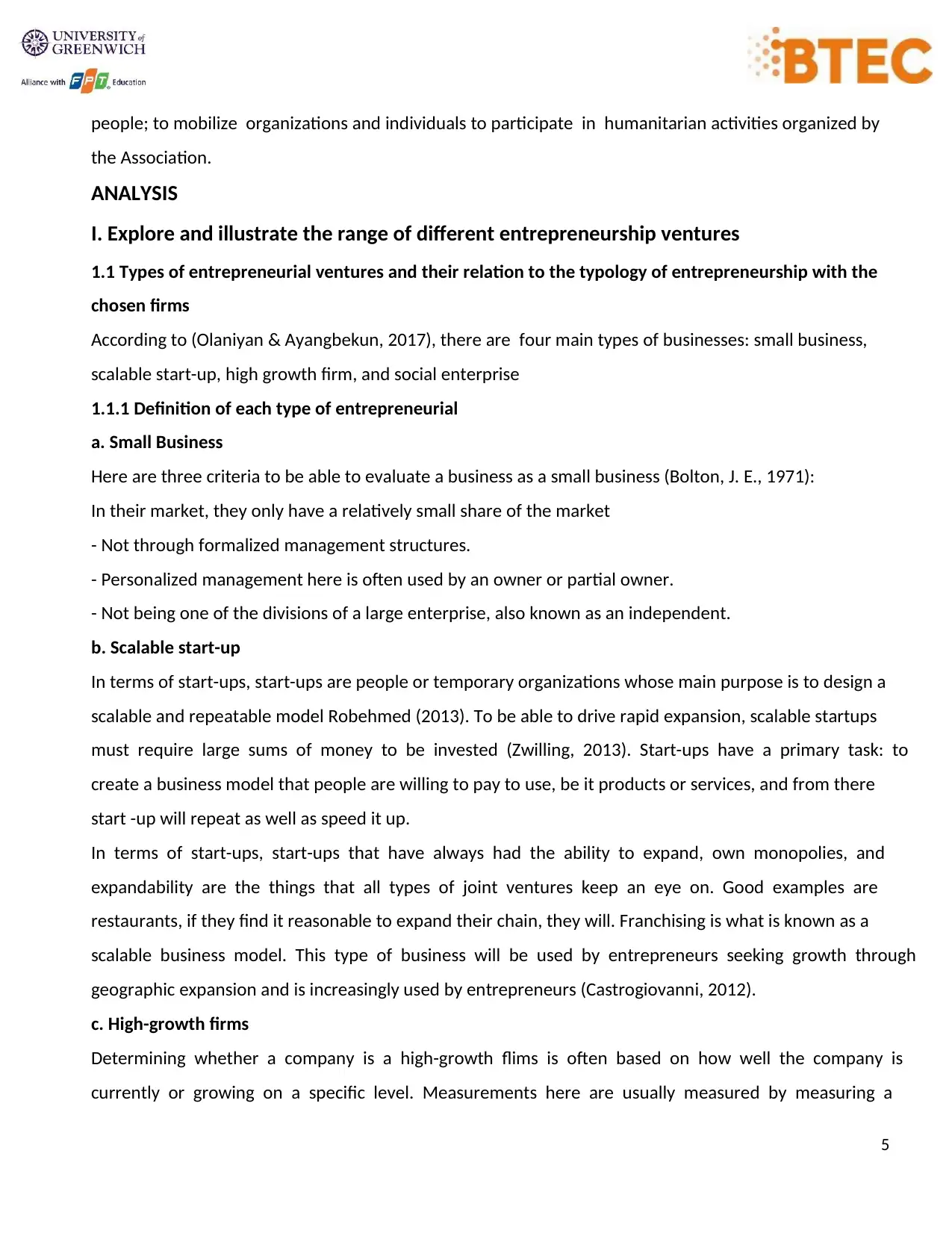
5
people; to mobilize organizations and individuals to participate in humanitarian activities organized by
the Association.
ANALYSIS
I. Explore and illustrate the range of different entrepreneurship ventures
1.1 Types of entrepreneurial ventures and their relation to the typology of entrepreneurship with the
chosen firms
According to (Olaniyan & Ayangbekun, 2017), there are four main types of businesses: small business,
scalable start-up, high growth firm, and social enterprise
1.1.1 Definition of each type of entrepreneurial
a. Small Business
Here are three criteria to be able to evaluate a business as a small business (Bolton, J. E., 1971):
In their market, they only have a relatively small share of the market
- Not through formalized management structures.
- Personalized management here is often used by an owner or partial owner.
- Not being one of the divisions of a large enterprise, also known as an independent.
b. Scalable start-up
In terms of start-ups, start-ups are people or temporary organizations whose main purpose is to design a
scalable and repeatable model Robehmed (2013). To be able to drive rapid expansion, scalable startups
must require large sums of money to be invested (Zwilling, 2013). Start-ups have a primary task: to
create a business model that people are willing to pay to use, be it products or services, and from there
start -up will repeat as well as speed it up.
In terms of start-ups, start-ups that have always had the ability to expand, own monopolies, and
expandability are the things that all types of joint ventures keep an eye on. Good examples are
restaurants, if they find it reasonable to expand their chain, they will. Franchising is what is known as a
scalable business model. This type of business will be used by entrepreneurs seeking growth through
geographic expansion and is increasingly used by entrepreneurs (Castrogiovanni, 2012).
c. High-growth firms
Determining whether a company is a high-growth flims is often based on how well the company is
currently or growing on a specific level. Measurements here are usually measured by measuring a
people; to mobilize organizations and individuals to participate in humanitarian activities organized by
the Association.
ANALYSIS
I. Explore and illustrate the range of different entrepreneurship ventures
1.1 Types of entrepreneurial ventures and their relation to the typology of entrepreneurship with the
chosen firms
According to (Olaniyan & Ayangbekun, 2017), there are four main types of businesses: small business,
scalable start-up, high growth firm, and social enterprise
1.1.1 Definition of each type of entrepreneurial
a. Small Business
Here are three criteria to be able to evaluate a business as a small business (Bolton, J. E., 1971):
In their market, they only have a relatively small share of the market
- Not through formalized management structures.
- Personalized management here is often used by an owner or partial owner.
- Not being one of the divisions of a large enterprise, also known as an independent.
b. Scalable start-up
In terms of start-ups, start-ups are people or temporary organizations whose main purpose is to design a
scalable and repeatable model Robehmed (2013). To be able to drive rapid expansion, scalable startups
must require large sums of money to be invested (Zwilling, 2013). Start-ups have a primary task: to
create a business model that people are willing to pay to use, be it products or services, and from there
start -up will repeat as well as speed it up.
In terms of start-ups, start-ups that have always had the ability to expand, own monopolies, and
expandability are the things that all types of joint ventures keep an eye on. Good examples are
restaurants, if they find it reasonable to expand their chain, they will. Franchising is what is known as a
scalable business model. This type of business will be used by entrepreneurs seeking growth through
geographic expansion and is increasingly used by entrepreneurs (Castrogiovanni, 2012).
c. High-growth firms
Determining whether a company is a high-growth flims is often based on how well the company is
currently or growing on a specific level. Measurements here are usually measured by measuring a
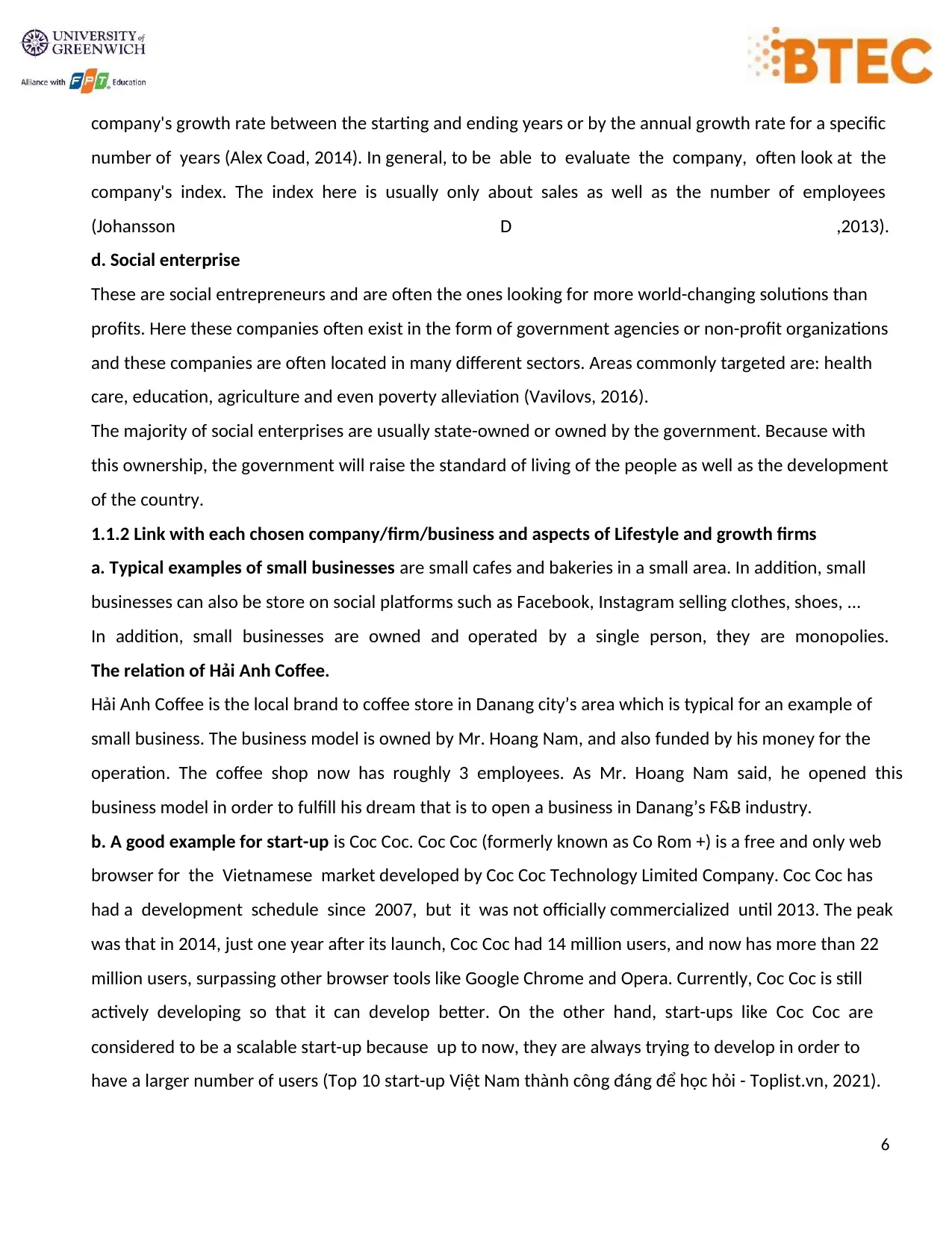
6
company's growth rate between the starting and ending years or by the annual growth rate for a specific
number of years (Alex Coad, 2014). In general, to be able to evaluate the company, often look at the
company's index. The index here is usually only about sales as well as the number of employees
(Johansson D ,2013).
d. Social enterprise
These are social entrepreneurs and are often the ones looking for more world-changing solutions than
profits. Here these companies often exist in the form of government agencies or non-profit organizations
and these companies are often located in many different sectors. Areas commonly targeted are: health
care, education, agriculture and even poverty alleviation (Vavilovs, 2016).
The majority of social enterprises are usually state-owned or owned by the government. Because with
this ownership, the government will raise the standard of living of the people as well as the development
of the country.
1.1.2 Link with each chosen company/firm/business and aspects of Lifestyle and growth firms
a. Typical examples of small businesses are small cafes and bakeries in a small area. In addition, small
businesses can also be store on social platforms such as Facebook, Instagram selling clothes, shoes, ...
In addition, small businesses are owned and operated by a single person, they are monopolies.
The relation of Hải Anh Coffee.
Hải Anh Coffee is the local brand to coffee store in Danang city’s area which is typical for an example of
small business. The business model is owned by Mr. Hoang Nam, and also funded by his money for the
operation. The coffee shop now has roughly 3 employees. As Mr. Hoang Nam said, he opened this
business model in order to fulfill his dream that is to open a business in Danang’s F&B industry.
b. A good example for start-up is Coc Coc. Coc Coc (formerly known as Co Rom +) is a free and only web
browser for the Vietnamese market developed by Coc Coc Technology Limited Company. Coc Coc has
had a development schedule since 2007, but it was not officially commercialized until 2013. The peak
was that in 2014, just one year after its launch, Coc Coc had 14 million users, and now has more than 22
million users, surpassing other browser tools like Google Chrome and Opera. Currently, Coc Coc is still
actively developing so that it can develop better. On the other hand, start-ups like Coc Coc are
considered to be a scalable start-up because up to now, they are always trying to develop in order to
have a larger number of users (Top 10 start-up Việt Nam thành công đáng để học hỏi - Toplist.vn, 2021).
company's growth rate between the starting and ending years or by the annual growth rate for a specific
number of years (Alex Coad, 2014). In general, to be able to evaluate the company, often look at the
company's index. The index here is usually only about sales as well as the number of employees
(Johansson D ,2013).
d. Social enterprise
These are social entrepreneurs and are often the ones looking for more world-changing solutions than
profits. Here these companies often exist in the form of government agencies or non-profit organizations
and these companies are often located in many different sectors. Areas commonly targeted are: health
care, education, agriculture and even poverty alleviation (Vavilovs, 2016).
The majority of social enterprises are usually state-owned or owned by the government. Because with
this ownership, the government will raise the standard of living of the people as well as the development
of the country.
1.1.2 Link with each chosen company/firm/business and aspects of Lifestyle and growth firms
a. Typical examples of small businesses are small cafes and bakeries in a small area. In addition, small
businesses can also be store on social platforms such as Facebook, Instagram selling clothes, shoes, ...
In addition, small businesses are owned and operated by a single person, they are monopolies.
The relation of Hải Anh Coffee.
Hải Anh Coffee is the local brand to coffee store in Danang city’s area which is typical for an example of
small business. The business model is owned by Mr. Hoang Nam, and also funded by his money for the
operation. The coffee shop now has roughly 3 employees. As Mr. Hoang Nam said, he opened this
business model in order to fulfill his dream that is to open a business in Danang’s F&B industry.
b. A good example for start-up is Coc Coc. Coc Coc (formerly known as Co Rom +) is a free and only web
browser for the Vietnamese market developed by Coc Coc Technology Limited Company. Coc Coc has
had a development schedule since 2007, but it was not officially commercialized until 2013. The peak
was that in 2014, just one year after its launch, Coc Coc had 14 million users, and now has more than 22
million users, surpassing other browser tools like Google Chrome and Opera. Currently, Coc Coc is still
actively developing so that it can develop better. On the other hand, start-ups like Coc Coc are
considered to be a scalable start-up because up to now, they are always trying to develop in order to
have a larger number of users (Top 10 start-up Việt Nam thành công đáng để học hỏi - Toplist.vn, 2021).
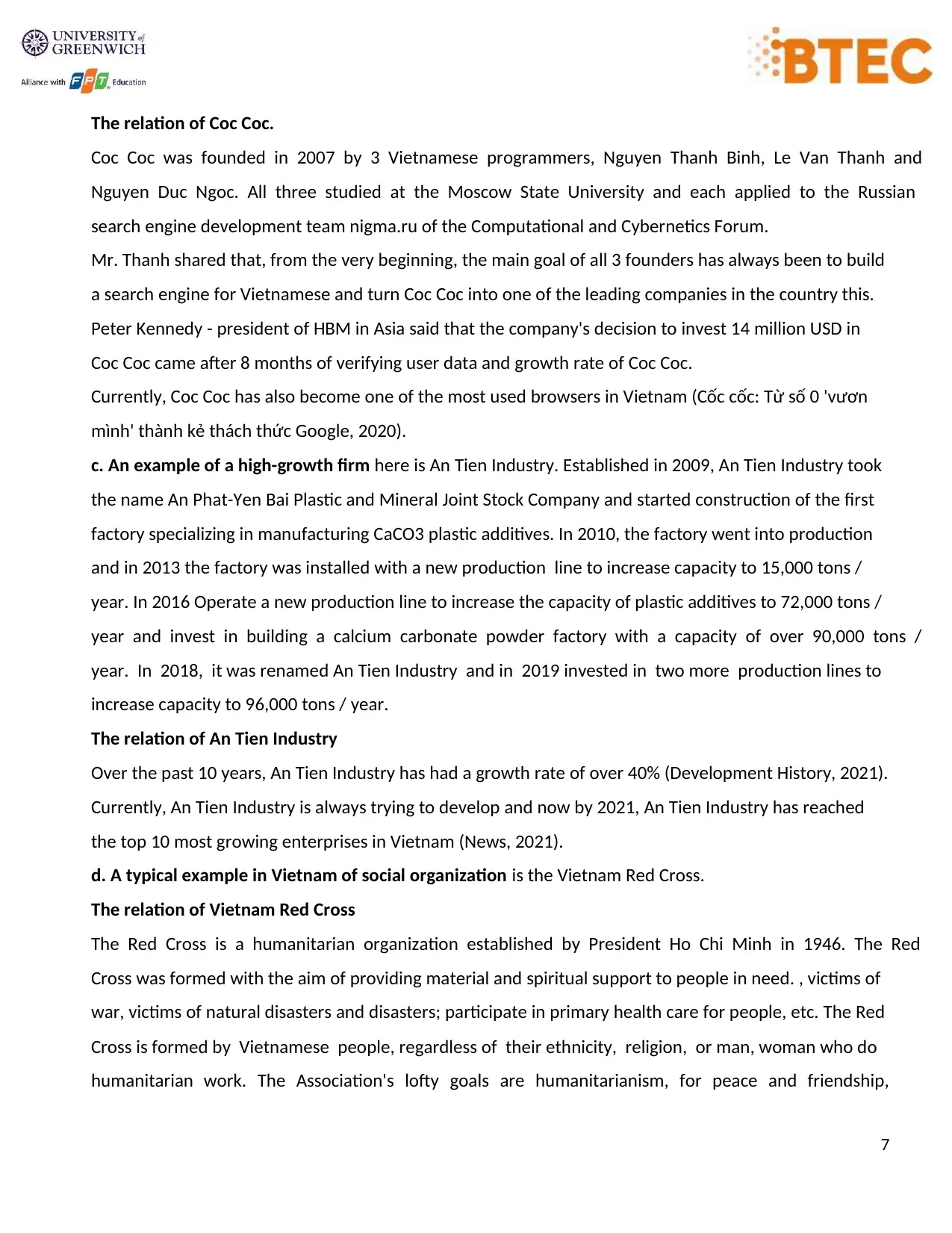
7
The relation of Coc Coc.
Coc Coc was founded in 2007 by 3 Vietnamese programmers, Nguyen Thanh Binh, Le Van Thanh and
Nguyen Duc Ngoc. All three studied at the Moscow State University and each applied to the Russian
search engine development team nigma.ru of the Computational and Cybernetics Forum.
Mr. Thanh shared that, from the very beginning, the main goal of all 3 founders has always been to build
a search engine for Vietnamese and turn Coc Coc into one of the leading companies in the country this.
Peter Kennedy - president of HBM in Asia said that the company's decision to invest 14 million USD in
Coc Coc came after 8 months of verifying user data and growth rate of Coc Coc.
Currently, Coc Coc has also become one of the most used browsers in Vietnam (Cốc cốc: Từ số 0 'vươn
mình' thành kẻ thách thức Google, 2020).
c. An example of a high-growth firm here is An Tien Industry. Established in 2009, An Tien Industry took
the name An Phat-Yen Bai Plastic and Mineral Joint Stock Company and started construction of the first
factory specializing in manufacturing CaCO3 plastic additives. In 2010, the factory went into production
and in 2013 the factory was installed with a new production line to increase capacity to 15,000 tons /
year. In 2016 Operate a new production line to increase the capacity of plastic additives to 72,000 tons /
year and invest in building a calcium carbonate powder factory with a capacity of over 90,000 tons /
year. In 2018, it was renamed An Tien Industry and in 2019 invested in two more production lines to
increase capacity to 96,000 tons / year.
The relation of An Tien Industry
Over the past 10 years, An Tien Industry has had a growth rate of over 40% (Development History, 2021).
Currently, An Tien Industry is always trying to develop and now by 2021, An Tien Industry has reached
the top 10 most growing enterprises in Vietnam (News, 2021).
d. A typical example in Vietnam of social organization is the Vietnam Red Cross.
The relation of Vietnam Red Cross
The Red Cross is a humanitarian organization established by President Ho Chi Minh in 1946. The Red
Cross was formed with the aim of providing material and spiritual support to people in need. , victims of
war, victims of natural disasters and disasters; participate in primary health care for people, etc. The Red
Cross is formed by Vietnamese people, regardless of their ethnicity, religion, or man, woman who do
humanitarian work. The Association's lofty goals are humanitarianism, for peace and friendship,
The relation of Coc Coc.
Coc Coc was founded in 2007 by 3 Vietnamese programmers, Nguyen Thanh Binh, Le Van Thanh and
Nguyen Duc Ngoc. All three studied at the Moscow State University and each applied to the Russian
search engine development team nigma.ru of the Computational and Cybernetics Forum.
Mr. Thanh shared that, from the very beginning, the main goal of all 3 founders has always been to build
a search engine for Vietnamese and turn Coc Coc into one of the leading companies in the country this.
Peter Kennedy - president of HBM in Asia said that the company's decision to invest 14 million USD in
Coc Coc came after 8 months of verifying user data and growth rate of Coc Coc.
Currently, Coc Coc has also become one of the most used browsers in Vietnam (Cốc cốc: Từ số 0 'vươn
mình' thành kẻ thách thức Google, 2020).
c. An example of a high-growth firm here is An Tien Industry. Established in 2009, An Tien Industry took
the name An Phat-Yen Bai Plastic and Mineral Joint Stock Company and started construction of the first
factory specializing in manufacturing CaCO3 plastic additives. In 2010, the factory went into production
and in 2013 the factory was installed with a new production line to increase capacity to 15,000 tons /
year. In 2016 Operate a new production line to increase the capacity of plastic additives to 72,000 tons /
year and invest in building a calcium carbonate powder factory with a capacity of over 90,000 tons /
year. In 2018, it was renamed An Tien Industry and in 2019 invested in two more production lines to
increase capacity to 96,000 tons / year.
The relation of An Tien Industry
Over the past 10 years, An Tien Industry has had a growth rate of over 40% (Development History, 2021).
Currently, An Tien Industry is always trying to develop and now by 2021, An Tien Industry has reached
the top 10 most growing enterprises in Vietnam (News, 2021).
d. A typical example in Vietnam of social organization is the Vietnam Red Cross.
The relation of Vietnam Red Cross
The Red Cross is a humanitarian organization established by President Ho Chi Minh in 1946. The Red
Cross was formed with the aim of providing material and spiritual support to people in need. , victims of
war, victims of natural disasters and disasters; participate in primary health care for people, etc. The Red
Cross is formed by Vietnamese people, regardless of their ethnicity, religion, or man, woman who do
humanitarian work. The Association's lofty goals are humanitarianism, for peace and friendship,
Paraphrase This Document
Need a fresh take? Get an instant paraphrase of this document with our AI Paraphraser
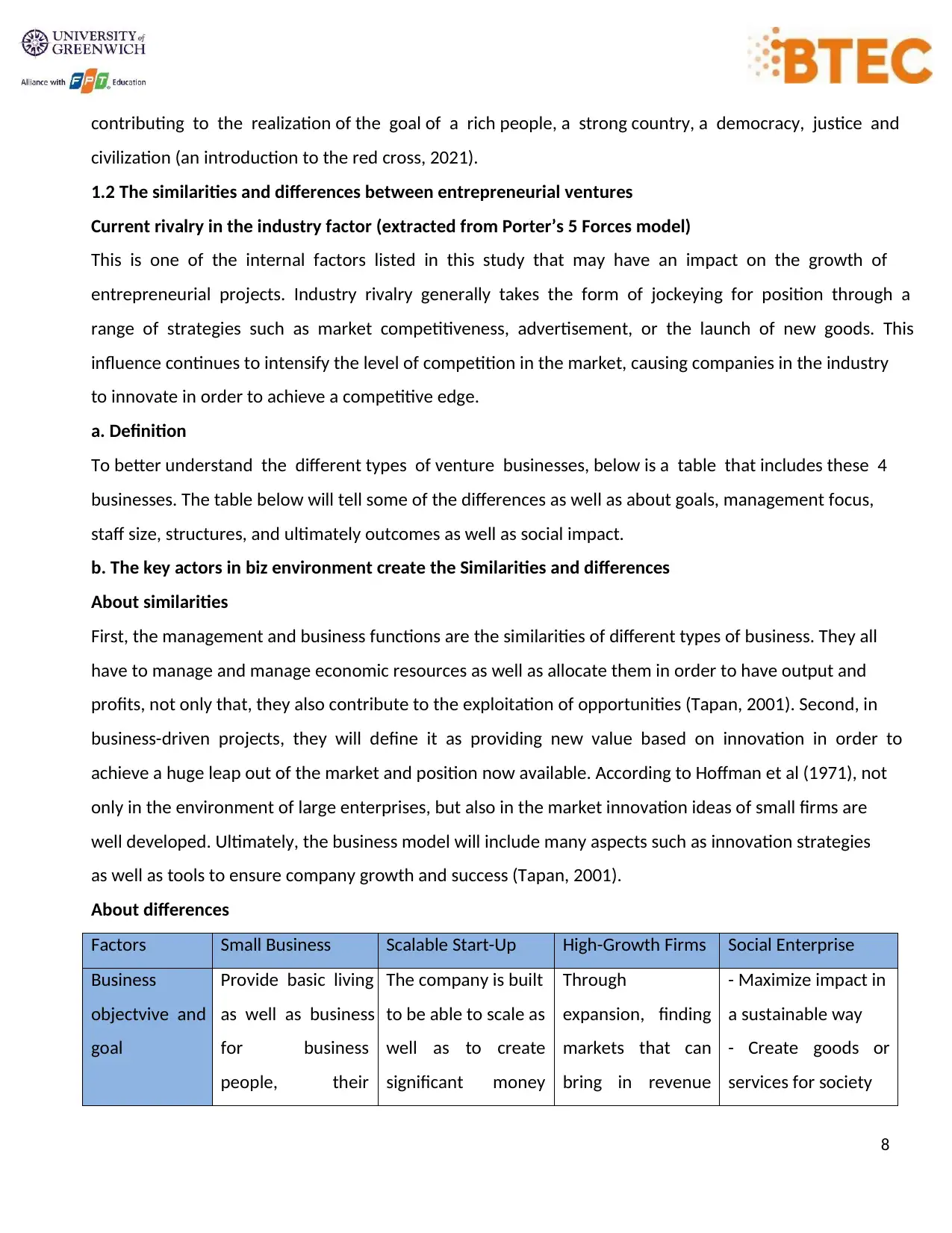
8
contributing to the realization of the goal of a rich people, a strong country, a democracy, justice and
civilization (an introduction to the red cross, 2021).
1.2 The similarities and differences between entrepreneurial ventures
Current rivalry in the industry factor (extracted from Porter’s 5 Forces model)
This is one of the internal factors listed in this study that may have an impact on the growth of
entrepreneurial projects. Industry rivalry generally takes the form of jockeying for position through a
range of strategies such as market competitiveness, advertisement, or the launch of new goods. This
influence continues to intensify the level of competition in the market, causing companies in the industry
to innovate in order to achieve a competitive edge.
a. Definition
To better understand the different types of venture businesses, below is a table that includes these 4
businesses. The table below will tell some of the differences as well as about goals, management focus,
staff size, structures, and ultimately outcomes as well as social impact.
b. The key actors in biz environment create the Similarities and differences
About similarities
First, the management and business functions are the similarities of different types of business. They all
have to manage and manage economic resources as well as allocate them in order to have output and
profits, not only that, they also contribute to the exploitation of opportunities (Tapan, 2001). Second, in
business-driven projects, they will define it as providing new value based on innovation in order to
achieve a huge leap out of the market and position now available. According to Hoffman et al (1971), not
only in the environment of large enterprises, but also in the market innovation ideas of small firms are
well developed. Ultimately, the business model will include many aspects such as innovation strategies
as well as tools to ensure company growth and success (Tapan, 2001).
About differences
Factors Small Business Scalable Start-Up High-Growth Firms Social Enterprise
Business
objectvive and
goal
Provide basic living
as well as business
for business
people, their
The company is built
to be able to scale as
well as to create
significant money
Through
expansion, finding
markets that can
bring in revenue
- Maximize impact in
a sustainable way
- Create goods or
services for society
contributing to the realization of the goal of a rich people, a strong country, a democracy, justice and
civilization (an introduction to the red cross, 2021).
1.2 The similarities and differences between entrepreneurial ventures
Current rivalry in the industry factor (extracted from Porter’s 5 Forces model)
This is one of the internal factors listed in this study that may have an impact on the growth of
entrepreneurial projects. Industry rivalry generally takes the form of jockeying for position through a
range of strategies such as market competitiveness, advertisement, or the launch of new goods. This
influence continues to intensify the level of competition in the market, causing companies in the industry
to innovate in order to achieve a competitive edge.
a. Definition
To better understand the different types of venture businesses, below is a table that includes these 4
businesses. The table below will tell some of the differences as well as about goals, management focus,
staff size, structures, and ultimately outcomes as well as social impact.
b. The key actors in biz environment create the Similarities and differences
About similarities
First, the management and business functions are the similarities of different types of business. They all
have to manage and manage economic resources as well as allocate them in order to have output and
profits, not only that, they also contribute to the exploitation of opportunities (Tapan, 2001). Second, in
business-driven projects, they will define it as providing new value based on innovation in order to
achieve a huge leap out of the market and position now available. According to Hoffman et al (1971), not
only in the environment of large enterprises, but also in the market innovation ideas of small firms are
well developed. Ultimately, the business model will include many aspects such as innovation strategies
as well as tools to ensure company growth and success (Tapan, 2001).
About differences
Factors Small Business Scalable Start-Up High-Growth Firms Social Enterprise
Business
objectvive and
goal
Provide basic living
as well as business
for business
people, their
The company is built
to be able to scale as
well as to create
significant money
Through
expansion, finding
markets that can
bring in revenue
- Maximize impact in
a sustainable way
- Create goods or
services for society
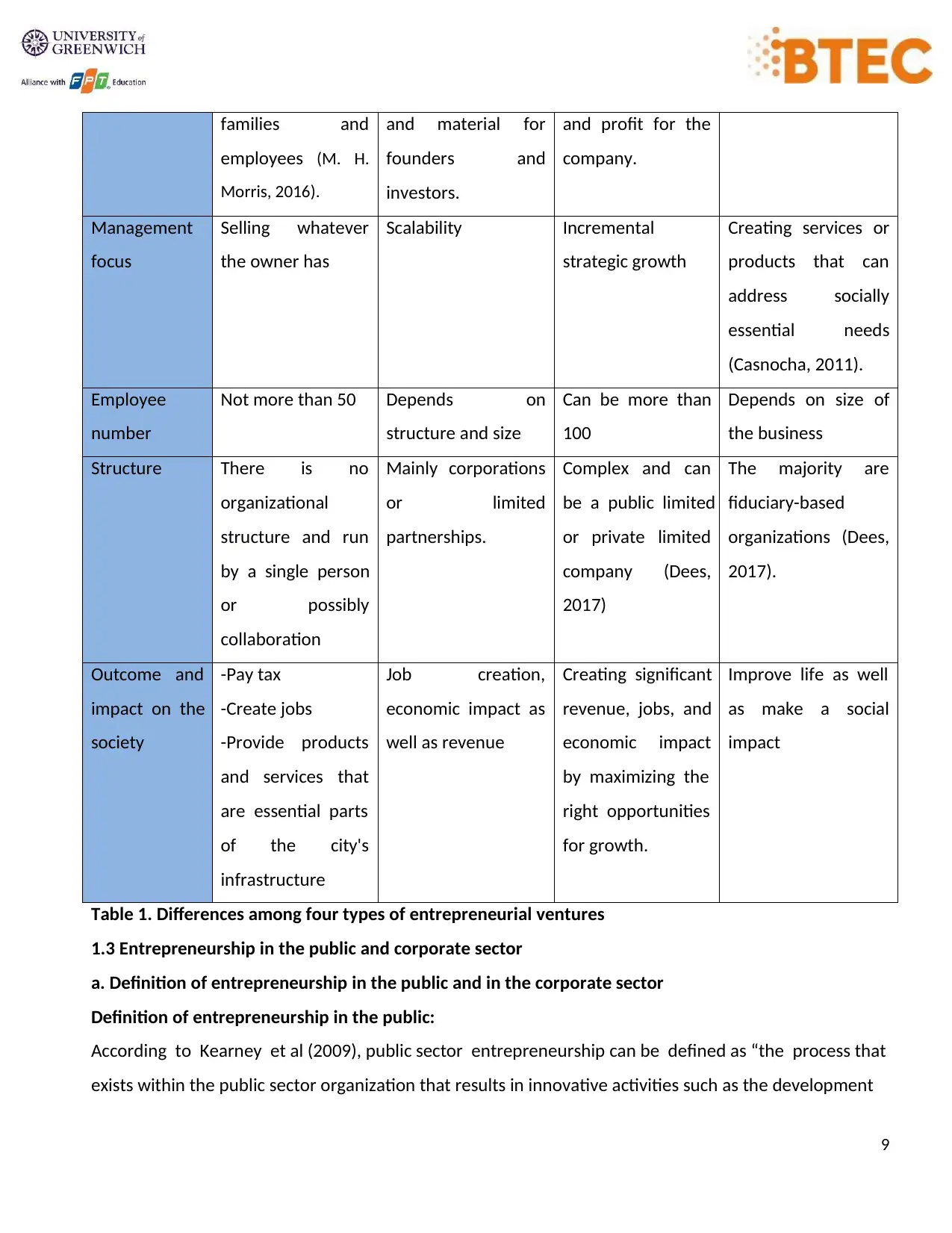
9
families and
employees (M. H.
Morris, 2016).
and material for
founders and
investors.
and profit for the
company.
Management
focus
Selling whatever
the owner has
Scalability Incremental
strategic growth
Creating services or
products that can
address socially
essential needs
(Casnocha, 2011).
Employee
number
Not more than 50 Depends on
structure and size
Can be more than
100
Depends on size of
the business
Structure There is no
organizational
structure and run
by a single person
or possibly
collaboration
Mainly corporations
or limited
partnerships.
Complex and can
be a public limited
or private limited
company (Dees,
2017)
The majority are
fiduciary-based
organizations (Dees,
2017).
Outcome and
impact on the
society
-Pay tax
-Create jobs
-Provide products
and services that
are essential parts
of the city's
infrastructure
Job creation,
economic impact as
well as revenue
Creating significant
revenue, jobs, and
economic impact
by maximizing the
right opportunities
for growth.
Improve life as well
as make a social
impact
Table 1. Differences among four types of entrepreneurial ventures
1.3 Entrepreneurship in the public and corporate sector
a. Definition of entrepreneurship in the public and in the corporate sector
Definition of entrepreneurship in the public:
According to Kearney et al (2009), public sector entrepreneurship can be defined as “the process that
exists within the public sector organization that results in innovative activities such as the development
families and
employees (M. H.
Morris, 2016).
and material for
founders and
investors.
and profit for the
company.
Management
focus
Selling whatever
the owner has
Scalability Incremental
strategic growth
Creating services or
products that can
address socially
essential needs
(Casnocha, 2011).
Employee
number
Not more than 50 Depends on
structure and size
Can be more than
100
Depends on size of
the business
Structure There is no
organizational
structure and run
by a single person
or possibly
collaboration
Mainly corporations
or limited
partnerships.
Complex and can
be a public limited
or private limited
company (Dees,
2017)
The majority are
fiduciary-based
organizations (Dees,
2017).
Outcome and
impact on the
society
-Pay tax
-Create jobs
-Provide products
and services that
are essential parts
of the city's
infrastructure
Job creation,
economic impact as
well as revenue
Creating significant
revenue, jobs, and
economic impact
by maximizing the
right opportunities
for growth.
Improve life as well
as make a social
impact
Table 1. Differences among four types of entrepreneurial ventures
1.3 Entrepreneurship in the public and corporate sector
a. Definition of entrepreneurship in the public and in the corporate sector
Definition of entrepreneurship in the public:
According to Kearney et al (2009), public sector entrepreneurship can be defined as “the process that
exists within the public sector organization that results in innovative activities such as the development
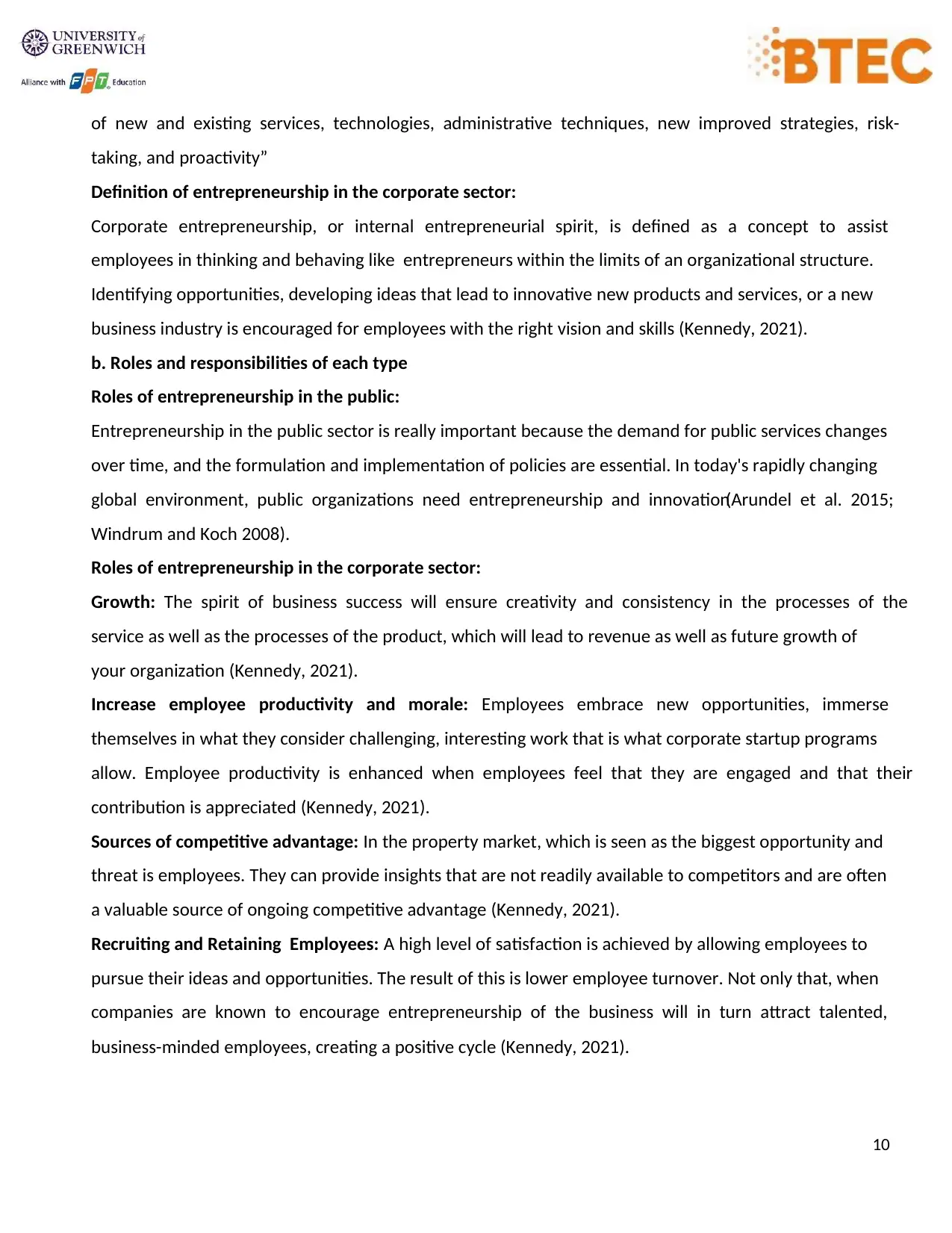
10
of new and existing services, technologies, administrative techniques, new improved strategies, risk-
taking, and proactivity”
Definition of entrepreneurship in the corporate sector:
Corporate entrepreneurship, or internal entrepreneurial spirit, is defined as a concept to assist
employees in thinking and behaving like entrepreneurs within the limits of an organizational structure.
Identifying opportunities, developing ideas that lead to innovative new products and services, or a new
business industry is encouraged for employees with the right vision and skills (Kennedy, 2021).
b. Roles and responsibilities of each type
Roles of entrepreneurship in the public:
Entrepreneurship in the public sector is really important because the demand for public services changes
over time, and the formulation and implementation of policies are essential. In today's rapidly changing
global environment, public organizations need entrepreneurship and innovation(Arundel et al. 2015;
Windrum and Koch 2008).
Roles of entrepreneurship in the corporate sector:
Growth: The spirit of business success will ensure creativity and consistency in the processes of the
service as well as the processes of the product, which will lead to revenue as well as future growth of
your organization (Kennedy, 2021).
Increase employee productivity and morale: Employees embrace new opportunities, immerse
themselves in what they consider challenging, interesting work that is what corporate startup programs
allow. Employee productivity is enhanced when employees feel that they are engaged and that their
contribution is appreciated (Kennedy, 2021).
Sources of competitive advantage: In the property market, which is seen as the biggest opportunity and
threat is employees. They can provide insights that are not readily available to competitors and are often
a valuable source of ongoing competitive advantage (Kennedy, 2021).
Recruiting and Retaining Employees: A high level of satisfaction is achieved by allowing employees to
pursue their ideas and opportunities. The result of this is lower employee turnover. Not only that, when
companies are known to encourage entrepreneurship of the business will in turn attract talented,
business-minded employees, creating a positive cycle (Kennedy, 2021).
of new and existing services, technologies, administrative techniques, new improved strategies, risk-
taking, and proactivity”
Definition of entrepreneurship in the corporate sector:
Corporate entrepreneurship, or internal entrepreneurial spirit, is defined as a concept to assist
employees in thinking and behaving like entrepreneurs within the limits of an organizational structure.
Identifying opportunities, developing ideas that lead to innovative new products and services, or a new
business industry is encouraged for employees with the right vision and skills (Kennedy, 2021).
b. Roles and responsibilities of each type
Roles of entrepreneurship in the public:
Entrepreneurship in the public sector is really important because the demand for public services changes
over time, and the formulation and implementation of policies are essential. In today's rapidly changing
global environment, public organizations need entrepreneurship and innovation(Arundel et al. 2015;
Windrum and Koch 2008).
Roles of entrepreneurship in the corporate sector:
Growth: The spirit of business success will ensure creativity and consistency in the processes of the
service as well as the processes of the product, which will lead to revenue as well as future growth of
your organization (Kennedy, 2021).
Increase employee productivity and morale: Employees embrace new opportunities, immerse
themselves in what they consider challenging, interesting work that is what corporate startup programs
allow. Employee productivity is enhanced when employees feel that they are engaged and that their
contribution is appreciated (Kennedy, 2021).
Sources of competitive advantage: In the property market, which is seen as the biggest opportunity and
threat is employees. They can provide insights that are not readily available to competitors and are often
a valuable source of ongoing competitive advantage (Kennedy, 2021).
Recruiting and Retaining Employees: A high level of satisfaction is achieved by allowing employees to
pursue their ideas and opportunities. The result of this is lower employee turnover. Not only that, when
companies are known to encourage entrepreneurship of the business will in turn attract talented,
business-minded employees, creating a positive cycle (Kennedy, 2021).
Secure Best Marks with AI Grader
Need help grading? Try our AI Grader for instant feedback on your assignments.

11
c. Critical points comparing
Differences
Factors Public sector entrepreneurship Private sector entrepreneurship
Objectives Greater diversity and multiplicity
of objectives; greater conflict
among objectives (Banfield, 1975; Rainey
et al., 1976; Cornwall and Perlman, 1990)
More clearly defined goals and
objectives; greater consistency among
objectives (Sadler, 2000)
Authority More authoritarian; more
centralized or centrally controlled (Downs,
1967; Pugh et al., 1969)
More democratic; more decentralized (Miller,
1983; Cornwall and Perlman, 1990; Slevin and
Covin, 1990; Miles and Arnold, 1991;
Jennings, 1994; Russell, 1999)
Decision
making
Less decision-making autonomy
and flexibility; more constrained
on procedures and operations;
subject to public scrutiny; major
decisions have to be transparent
(Rainey et al., 1976; Rainey, 1997)
Greater degree of flexibility and
autonomy in the decision-making
process; more participative and
independent in their decision making (Pearce
and David, 1983; Jennings and Lumpkin,
1989)
Rewards/
motivation
Lower financial incentives; does
not share enterprise’s profits
(Ramamurti, 1986; Morris and
Jones, 1999). Lower commitment
and job satisfaction (Rhinehart
et al., 1969; Buchanon, 1974a, b;
Rainey, 1983; Boyne, 2002)
Calculated risk taker; invest personal capital
in the business; higher financial incentives;
profitability is fundamental to generate
income (Ramamurti, 1986; Hornsby et al.,
2002). Greater level of commitment and job
satisfaction (Rhinehart et al., 1969;
Buchanon, 1974b; Rainey, 1983; Hornsby et
al., 2002)
Innovation Public managers are
entrepreneurial in the way they
take risks with an opportunistic
bias toward action and
Create value through innovation and seizing
that opportunity without regard to either
resources (human and capital); produces
resources or endows
c. Critical points comparing
Differences
Factors Public sector entrepreneurship Private sector entrepreneurship
Objectives Greater diversity and multiplicity
of objectives; greater conflict
among objectives (Banfield, 1975; Rainey
et al., 1976; Cornwall and Perlman, 1990)
More clearly defined goals and
objectives; greater consistency among
objectives (Sadler, 2000)
Authority More authoritarian; more
centralized or centrally controlled (Downs,
1967; Pugh et al., 1969)
More democratic; more decentralized (Miller,
1983; Cornwall and Perlman, 1990; Slevin and
Covin, 1990; Miles and Arnold, 1991;
Jennings, 1994; Russell, 1999)
Decision
making
Less decision-making autonomy
and flexibility; more constrained
on procedures and operations;
subject to public scrutiny; major
decisions have to be transparent
(Rainey et al., 1976; Rainey, 1997)
Greater degree of flexibility and
autonomy in the decision-making
process; more participative and
independent in their decision making (Pearce
and David, 1983; Jennings and Lumpkin,
1989)
Rewards/
motivation
Lower financial incentives; does
not share enterprise’s profits
(Ramamurti, 1986; Morris and
Jones, 1999). Lower commitment
and job satisfaction (Rhinehart
et al., 1969; Buchanon, 1974a, b;
Rainey, 1983; Boyne, 2002)
Calculated risk taker; invest personal capital
in the business; higher financial incentives;
profitability is fundamental to generate
income (Ramamurti, 1986; Hornsby et al.,
2002). Greater level of commitment and job
satisfaction (Rhinehart et al., 1969;
Buchanon, 1974b; Rainey, 1983; Hornsby et
al., 2002)
Innovation Public managers are
entrepreneurial in the way they
take risks with an opportunistic
bias toward action and
Create value through innovation and seizing
that opportunity without regard to either
resources (human and capital); produces
resources or endows
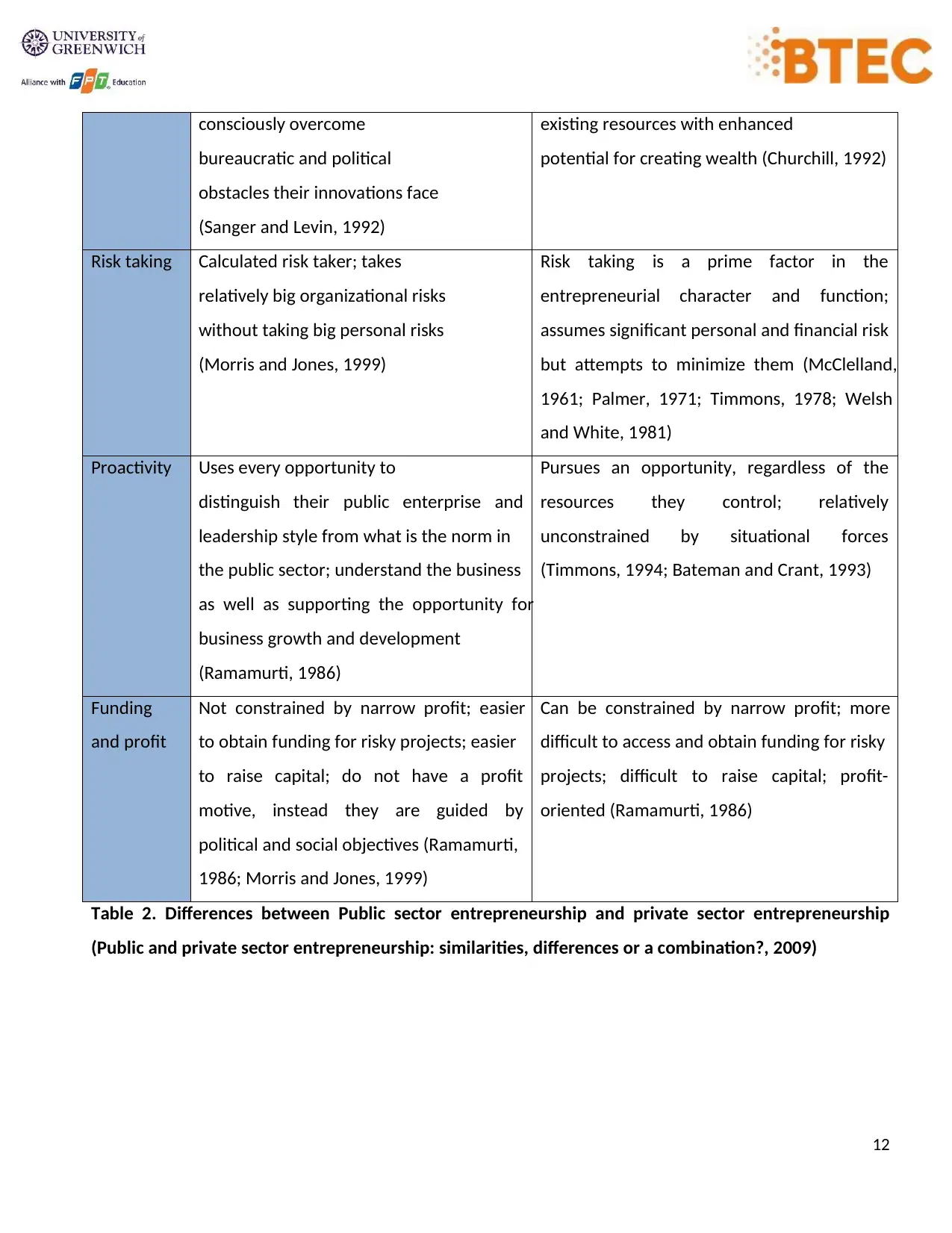
12
consciously overcome
bureaucratic and political
obstacles their innovations face
(Sanger and Levin, 1992)
existing resources with enhanced
potential for creating wealth (Churchill, 1992)
Risk taking Calculated risk taker; takes
relatively big organizational risks
without taking big personal risks
(Morris and Jones, 1999)
Risk taking is a prime factor in the
entrepreneurial character and function;
assumes significant personal and financial risk
but attempts to minimize them (McClelland,
1961; Palmer, 1971; Timmons, 1978; Welsh
and White, 1981)
Proactivity Uses every opportunity to
distinguish their public enterprise and
leadership style from what is the norm in
the public sector; understand the business
as well as supporting the opportunity for
business growth and development
(Ramamurti, 1986)
Pursues an opportunity, regardless of the
resources they control; relatively
unconstrained by situational forces
(Timmons, 1994; Bateman and Crant, 1993)
Funding
and profit
Not constrained by narrow profit; easier
to obtain funding for risky projects; easier
to raise capital; do not have a profit
motive, instead they are guided by
political and social objectives (Ramamurti,
1986; Morris and Jones, 1999)
Can be constrained by narrow profit; more
difficult to access and obtain funding for risky
projects; difficult to raise capital; profit-
oriented (Ramamurti, 1986)
Table 2. Differences between Public sector entrepreneurship and private sector entrepreneurship
(Public and private sector entrepreneurship: similarities, differences or a combination?, 2009)
consciously overcome
bureaucratic and political
obstacles their innovations face
(Sanger and Levin, 1992)
existing resources with enhanced
potential for creating wealth (Churchill, 1992)
Risk taking Calculated risk taker; takes
relatively big organizational risks
without taking big personal risks
(Morris and Jones, 1999)
Risk taking is a prime factor in the
entrepreneurial character and function;
assumes significant personal and financial risk
but attempts to minimize them (McClelland,
1961; Palmer, 1971; Timmons, 1978; Welsh
and White, 1981)
Proactivity Uses every opportunity to
distinguish their public enterprise and
leadership style from what is the norm in
the public sector; understand the business
as well as supporting the opportunity for
business growth and development
(Ramamurti, 1986)
Pursues an opportunity, regardless of the
resources they control; relatively
unconstrained by situational forces
(Timmons, 1994; Bateman and Crant, 1993)
Funding
and profit
Not constrained by narrow profit; easier
to obtain funding for risky projects; easier
to raise capital; do not have a profit
motive, instead they are guided by
political and social objectives (Ramamurti,
1986; Morris and Jones, 1999)
Can be constrained by narrow profit; more
difficult to access and obtain funding for risky
projects; difficult to raise capital; profit-
oriented (Ramamurti, 1986)
Table 2. Differences between Public sector entrepreneurship and private sector entrepreneurship
(Public and private sector entrepreneurship: similarities, differences or a combination?, 2009)
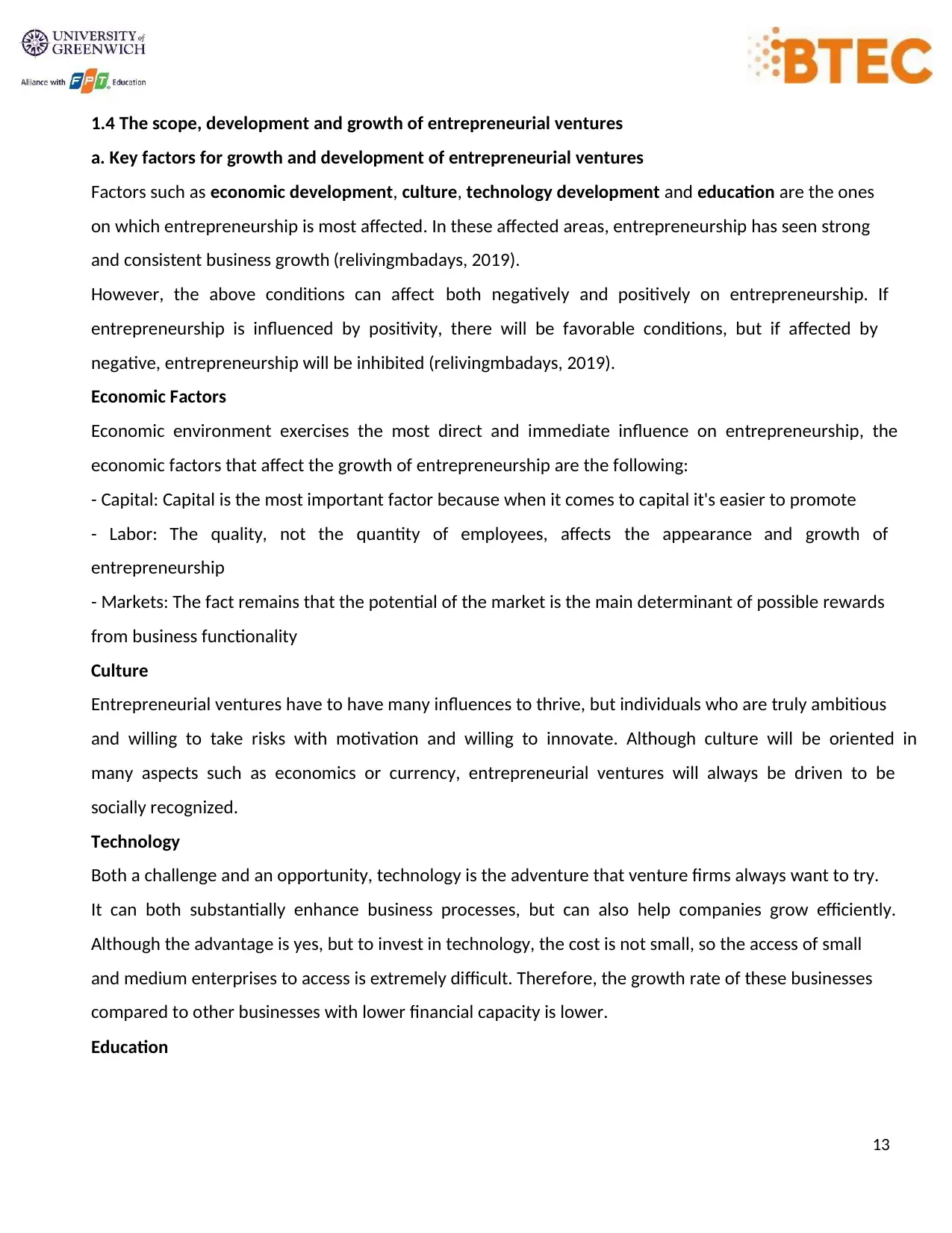
13
1.4 The scope, development and growth of entrepreneurial ventures
a. Key factors for growth and development of entrepreneurial ventures
Factors such as economic development, culture, technology development and education are the ones
on which entrepreneurship is most affected. In these affected areas, entrepreneurship has seen strong
and consistent business growth (relivingmbadays, 2019).
However, the above conditions can affect both negatively and positively on entrepreneurship. If
entrepreneurship is influenced by positivity, there will be favorable conditions, but if affected by
negative, entrepreneurship will be inhibited (relivingmbadays, 2019).
Economic Factors
Economic environment exercises the most direct and immediate influence on entrepreneurship, the
economic factors that affect the growth of entrepreneurship are the following:
- Capital: Capital is the most important factor because when it comes to capital it's easier to promote
- Labor: The quality, not the quantity of employees, affects the appearance and growth of
entrepreneurship
- Markets: The fact remains that the potential of the market is the main determinant of possible rewards
from business functionality
Culture
Entrepreneurial ventures have to have many influences to thrive, but individuals who are truly ambitious
and willing to take risks with motivation and willing to innovate. Although culture will be oriented in
many aspects such as economics or currency, entrepreneurial ventures will always be driven to be
socially recognized.
Technology
Both a challenge and an opportunity, technology is the adventure that venture firms always want to try.
It can both substantially enhance business processes, but can also help companies grow efficiently.
Although the advantage is yes, but to invest in technology, the cost is not small, so the access of small
and medium enterprises to access is extremely difficult. Therefore, the growth rate of these businesses
compared to other businesses with lower financial capacity is lower.
Education
1.4 The scope, development and growth of entrepreneurial ventures
a. Key factors for growth and development of entrepreneurial ventures
Factors such as economic development, culture, technology development and education are the ones
on which entrepreneurship is most affected. In these affected areas, entrepreneurship has seen strong
and consistent business growth (relivingmbadays, 2019).
However, the above conditions can affect both negatively and positively on entrepreneurship. If
entrepreneurship is influenced by positivity, there will be favorable conditions, but if affected by
negative, entrepreneurship will be inhibited (relivingmbadays, 2019).
Economic Factors
Economic environment exercises the most direct and immediate influence on entrepreneurship, the
economic factors that affect the growth of entrepreneurship are the following:
- Capital: Capital is the most important factor because when it comes to capital it's easier to promote
- Labor: The quality, not the quantity of employees, affects the appearance and growth of
entrepreneurship
- Markets: The fact remains that the potential of the market is the main determinant of possible rewards
from business functionality
Culture
Entrepreneurial ventures have to have many influences to thrive, but individuals who are truly ambitious
and willing to take risks with motivation and willing to innovate. Although culture will be oriented in
many aspects such as economics or currency, entrepreneurial ventures will always be driven to be
socially recognized.
Technology
Both a challenge and an opportunity, technology is the adventure that venture firms always want to try.
It can both substantially enhance business processes, but can also help companies grow efficiently.
Although the advantage is yes, but to invest in technology, the cost is not small, so the access of small
and medium enterprises to access is extremely difficult. Therefore, the growth rate of these businesses
compared to other businesses with lower financial capacity is lower.
Education
Paraphrase This Document
Need a fresh take? Get an instant paraphrase of this document with our AI Paraphraser
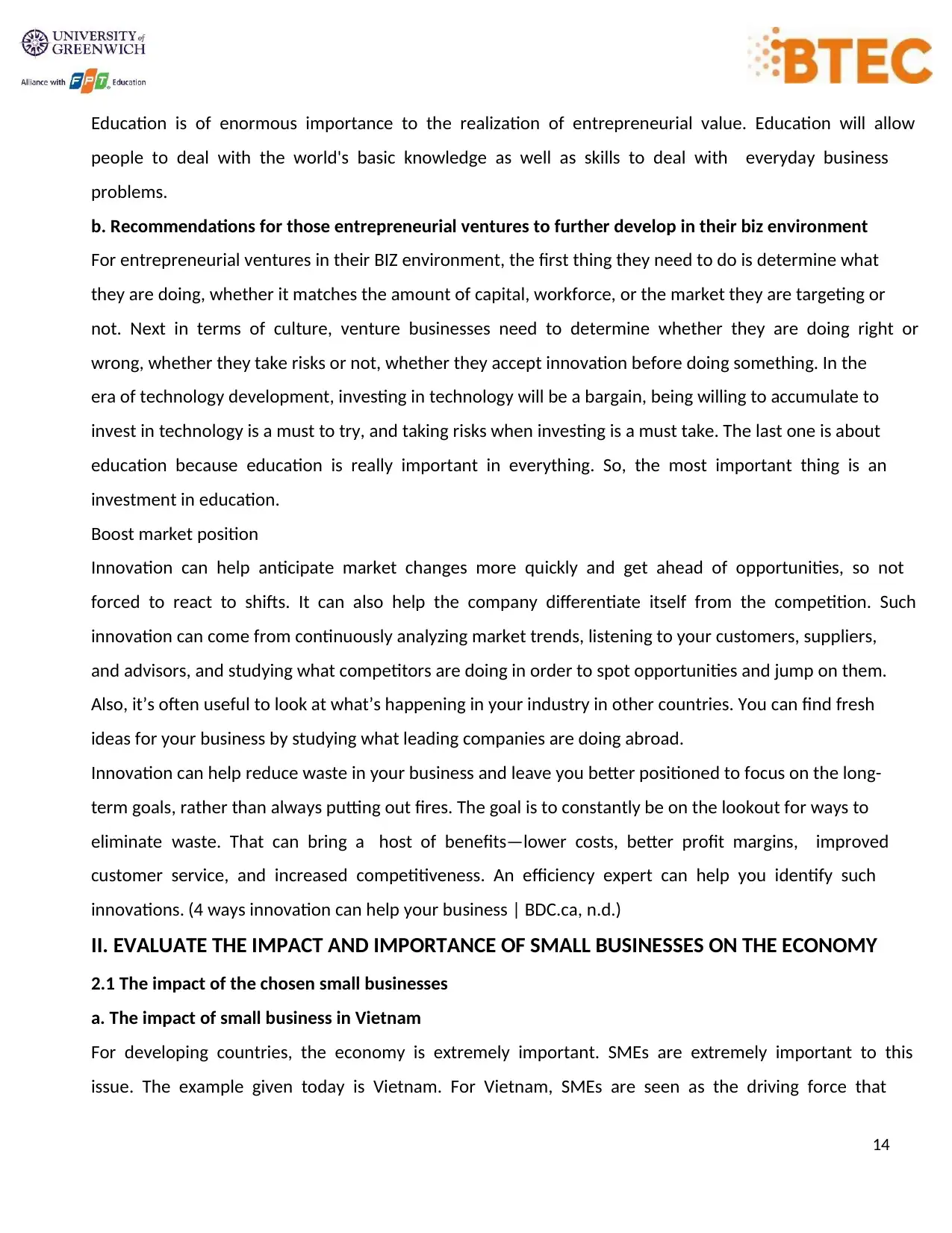
14
Education is of enormous importance to the realization of entrepreneurial value. Education will allow
people to deal with the world's basic knowledge as well as skills to deal with everyday business
problems.
b. Recommendations for those entrepreneurial ventures to further develop in their biz environment
For entrepreneurial ventures in their BIZ environment, the first thing they need to do is determine what
they are doing, whether it matches the amount of capital, workforce, or the market they are targeting or
not. Next in terms of culture, venture businesses need to determine whether they are doing right or
wrong, whether they take risks or not, whether they accept innovation before doing something. In the
era of technology development, investing in technology will be a bargain, being willing to accumulate to
invest in technology is a must to try, and taking risks when investing is a must take. The last one is about
education because education is really important in everything. So, the most important thing is an
investment in education.
Boost market position
Innovation can help anticipate market changes more quickly and get ahead of opportunities, so not
forced to react to shifts. It can also help the company differentiate itself from the competition. Such
innovation can come from continuously analyzing market trends, listening to your customers, suppliers,
and advisors, and studying what competitors are doing in order to spot opportunities and jump on them.
Also, it’s often useful to look at what’s happening in your industry in other countries. You can find fresh
ideas for your business by studying what leading companies are doing abroad.
Innovation can help reduce waste in your business and leave you better positioned to focus on the long-
term goals, rather than always putting out fires. The goal is to constantly be on the lookout for ways to
eliminate waste. That can bring a host of benefits—lower costs, better profit margins, improved
customer service, and increased competitiveness. An efficiency expert can help you identify such
innovations. (4 ways innovation can help your business | BDC.ca, n.d.)
II. EVALUATE THE IMPACT AND IMPORTANCE OF SMALL BUSINESSES ON THE ECONOMY
2.1 The impact of the chosen small businesses
a. The impact of small business in Vietnam
For developing countries, the economy is extremely important. SMEs are extremely important to this
issue. The example given today is Vietnam. For Vietnam, SMEs are seen as the driving force that
Education is of enormous importance to the realization of entrepreneurial value. Education will allow
people to deal with the world's basic knowledge as well as skills to deal with everyday business
problems.
b. Recommendations for those entrepreneurial ventures to further develop in their biz environment
For entrepreneurial ventures in their BIZ environment, the first thing they need to do is determine what
they are doing, whether it matches the amount of capital, workforce, or the market they are targeting or
not. Next in terms of culture, venture businesses need to determine whether they are doing right or
wrong, whether they take risks or not, whether they accept innovation before doing something. In the
era of technology development, investing in technology will be a bargain, being willing to accumulate to
invest in technology is a must to try, and taking risks when investing is a must take. The last one is about
education because education is really important in everything. So, the most important thing is an
investment in education.
Boost market position
Innovation can help anticipate market changes more quickly and get ahead of opportunities, so not
forced to react to shifts. It can also help the company differentiate itself from the competition. Such
innovation can come from continuously analyzing market trends, listening to your customers, suppliers,
and advisors, and studying what competitors are doing in order to spot opportunities and jump on them.
Also, it’s often useful to look at what’s happening in your industry in other countries. You can find fresh
ideas for your business by studying what leading companies are doing abroad.
Innovation can help reduce waste in your business and leave you better positioned to focus on the long-
term goals, rather than always putting out fires. The goal is to constantly be on the lookout for ways to
eliminate waste. That can bring a host of benefits—lower costs, better profit margins, improved
customer service, and increased competitiveness. An efficiency expert can help you identify such
innovations. (4 ways innovation can help your business | BDC.ca, n.d.)
II. EVALUATE THE IMPACT AND IMPORTANCE OF SMALL BUSINESSES ON THE ECONOMY
2.1 The impact of the chosen small businesses
a. The impact of small business in Vietnam
For developing countries, the economy is extremely important. SMEs are extremely important to this
issue. The example given today is Vietnam. For Vietnam, SMEs are seen as the driving force that

15
contributes greatly to the Gross Domestic Product (GDP) and creates new power. In addition, the leaders
in sustainability as well as the environment are the SMEs themselves. This also contributes to economic
prosperity, diversity, innovation, and also creates and maintains healthy competition (Phuong Anh, Thuy
Anh and Quang Dung, 2020).
Figure 1: Portion of SMEs in Vietnam in 2018. Source: General Statistics Office in Vietnam (2018)
According to the General Statistics Office of Vietnam (2018), in terms of the number of enterprises in
Vietnam, 97% are SMEs. The SMEs here have a key role to play in addressing social aspects as well as
promoting urbanization (Phuong Anh, Thuy Anh and Quang Dung, 2020). In December 2019, SMEs
contributed up to 40% of GDP, 30% of Vietnam's total budget revenue, 60% of the people employed by
SMEs and Vietnam's budget increased to 18.4% after about 10 from 2006 to 2016 (Phuong Anh, Thuy
Anh and Quang Dung, 2020).
b. The impact of the chosen small business
According to Mr. Hoang Nam, currently the owner of Hai Anh coffee shop, his small coffee shop is just
one of many cafes in Da Nang. But, his coffee shop is a place for people to relax and enjoy the best
coffee. Saying that Hai Anh's activities also play a part in creating diversity for small businesses in Da
Nang. In addition, the Hai Anh cafe also creates jobs.
2.2 The importance of small businesses and business start-ups to the growth of the social economy
a. The definition of social economy
contributes greatly to the Gross Domestic Product (GDP) and creates new power. In addition, the leaders
in sustainability as well as the environment are the SMEs themselves. This also contributes to economic
prosperity, diversity, innovation, and also creates and maintains healthy competition (Phuong Anh, Thuy
Anh and Quang Dung, 2020).
Figure 1: Portion of SMEs in Vietnam in 2018. Source: General Statistics Office in Vietnam (2018)
According to the General Statistics Office of Vietnam (2018), in terms of the number of enterprises in
Vietnam, 97% are SMEs. The SMEs here have a key role to play in addressing social aspects as well as
promoting urbanization (Phuong Anh, Thuy Anh and Quang Dung, 2020). In December 2019, SMEs
contributed up to 40% of GDP, 30% of Vietnam's total budget revenue, 60% of the people employed by
SMEs and Vietnam's budget increased to 18.4% after about 10 from 2006 to 2016 (Phuong Anh, Thuy
Anh and Quang Dung, 2020).
b. The impact of the chosen small business
According to Mr. Hoang Nam, currently the owner of Hai Anh coffee shop, his small coffee shop is just
one of many cafes in Da Nang. But, his coffee shop is a place for people to relax and enjoy the best
coffee. Saying that Hai Anh's activities also play a part in creating diversity for small businesses in Da
Nang. In addition, the Hai Anh cafe also creates jobs.
2.2 The importance of small businesses and business start-ups to the growth of the social economy
a. The definition of social economy
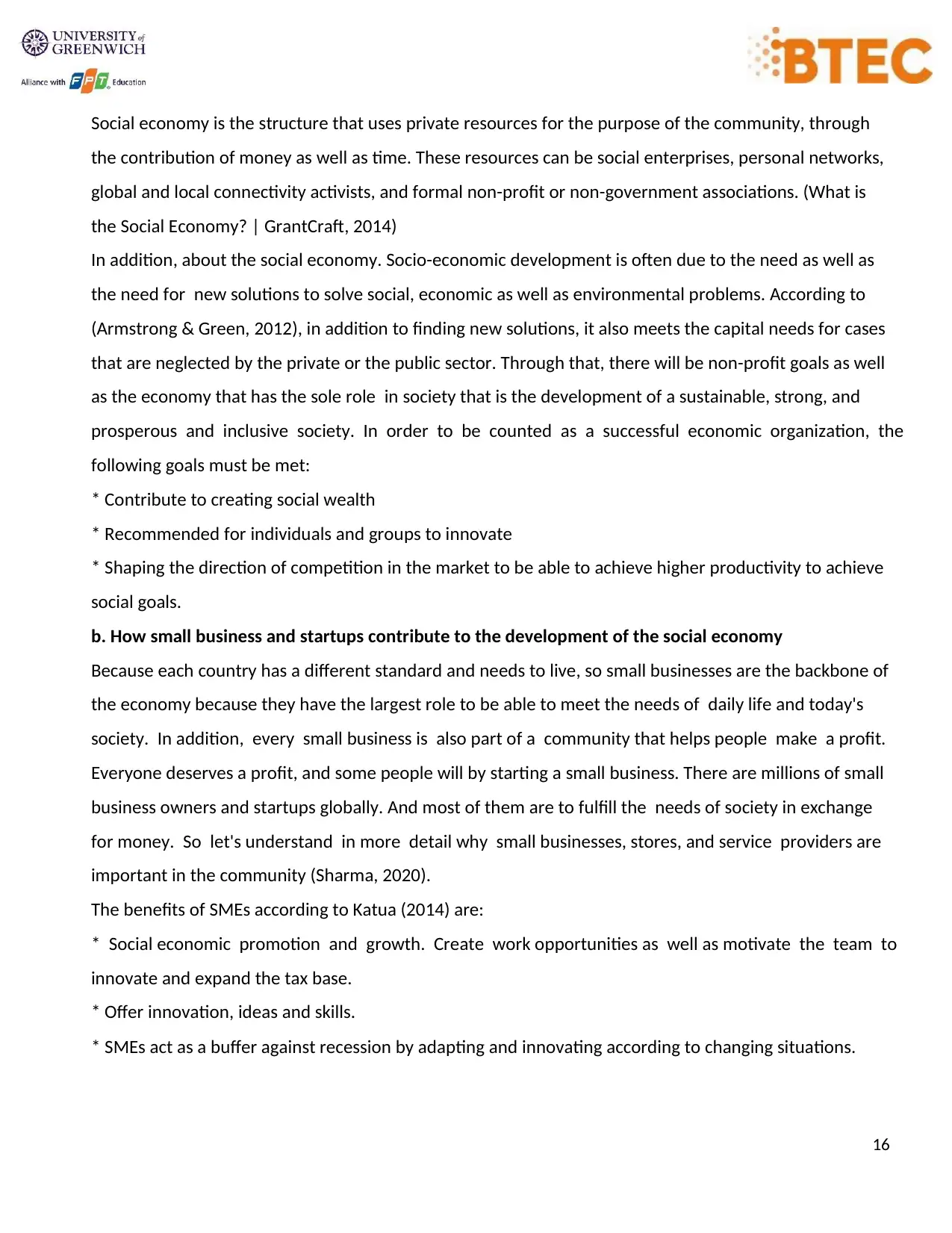
16
Social economy is the structure that uses private resources for the purpose of the community, through
the contribution of money as well as time. These resources can be social enterprises, personal networks,
global and local connectivity activists, and formal non-profit or non-government associations. (What is
the Social Economy? | GrantCraft, 2014)
In addition, about the social economy. Socio-economic development is often due to the need as well as
the need for new solutions to solve social, economic as well as environmental problems. According to
(Armstrong & Green, 2012), in addition to finding new solutions, it also meets the capital needs for cases
that are neglected by the private or the public sector. Through that, there will be non-profit goals as well
as the economy that has the sole role in society that is the development of a sustainable, strong, and
prosperous and inclusive society. In order to be counted as a successful economic organization, the
following goals must be met:
* Contribute to creating social wealth
* Recommended for individuals and groups to innovate
* Shaping the direction of competition in the market to be able to achieve higher productivity to achieve
social goals.
b. How small business and startups contribute to the development of the social economy
Because each country has a different standard and needs to live, so small businesses are the backbone of
the economy because they have the largest role to be able to meet the needs of daily life and today's
society. In addition, every small business is also part of a community that helps people make a profit.
Everyone deserves a profit, and some people will by starting a small business. There are millions of small
business owners and startups globally. And most of them are to fulfill the needs of society in exchange
for money. So let's understand in more detail why small businesses, stores, and service providers are
important in the community (Sharma, 2020).
The benefits of SMEs according to Katua (2014) are:
* Social economic promotion and growth. Create work opportunities as well as motivate the team to
innovate and expand the tax base.
* Offer innovation, ideas and skills.
* SMEs act as a buffer against recession by adapting and innovating according to changing situations.
Social economy is the structure that uses private resources for the purpose of the community, through
the contribution of money as well as time. These resources can be social enterprises, personal networks,
global and local connectivity activists, and formal non-profit or non-government associations. (What is
the Social Economy? | GrantCraft, 2014)
In addition, about the social economy. Socio-economic development is often due to the need as well as
the need for new solutions to solve social, economic as well as environmental problems. According to
(Armstrong & Green, 2012), in addition to finding new solutions, it also meets the capital needs for cases
that are neglected by the private or the public sector. Through that, there will be non-profit goals as well
as the economy that has the sole role in society that is the development of a sustainable, strong, and
prosperous and inclusive society. In order to be counted as a successful economic organization, the
following goals must be met:
* Contribute to creating social wealth
* Recommended for individuals and groups to innovate
* Shaping the direction of competition in the market to be able to achieve higher productivity to achieve
social goals.
b. How small business and startups contribute to the development of the social economy
Because each country has a different standard and needs to live, so small businesses are the backbone of
the economy because they have the largest role to be able to meet the needs of daily life and today's
society. In addition, every small business is also part of a community that helps people make a profit.
Everyone deserves a profit, and some people will by starting a small business. There are millions of small
business owners and startups globally. And most of them are to fulfill the needs of society in exchange
for money. So let's understand in more detail why small businesses, stores, and service providers are
important in the community (Sharma, 2020).
The benefits of SMEs according to Katua (2014) are:
* Social economic promotion and growth. Create work opportunities as well as motivate the team to
innovate and expand the tax base.
* Offer innovation, ideas and skills.
* SMEs act as a buffer against recession by adapting and innovating according to changing situations.
Secure Best Marks with AI Grader
Need help grading? Try our AI Grader for instant feedback on your assignments.
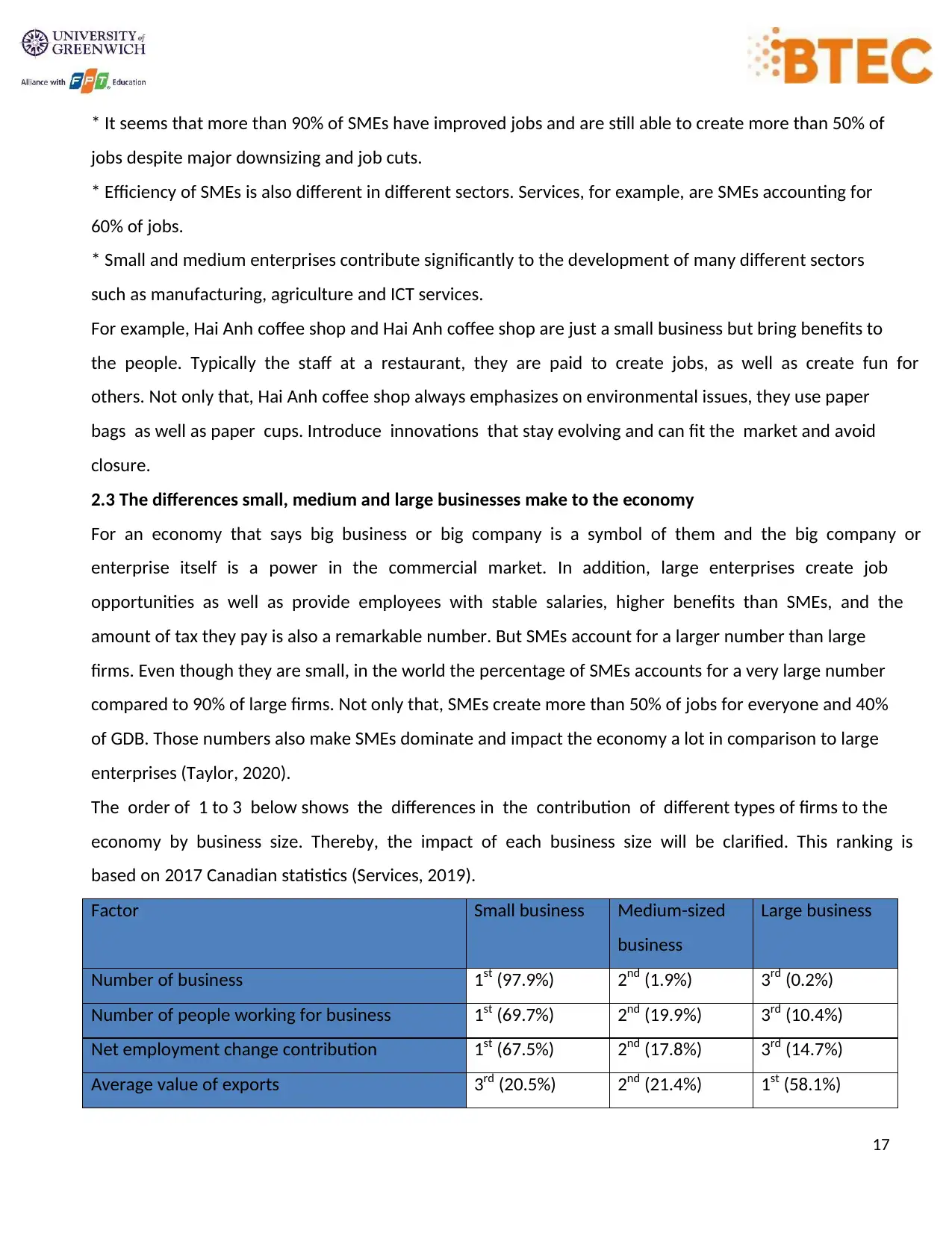
17
* It seems that more than 90% of SMEs have improved jobs and are still able to create more than 50% of
jobs despite major downsizing and job cuts.
* Efficiency of SMEs is also different in different sectors. Services, for example, are SMEs accounting for
60% of jobs.
* Small and medium enterprises contribute significantly to the development of many different sectors
such as manufacturing, agriculture and ICT services.
For example, Hai Anh coffee shop and Hai Anh coffee shop are just a small business but bring benefits to
the people. Typically the staff at a restaurant, they are paid to create jobs, as well as create fun for
others. Not only that, Hai Anh coffee shop always emphasizes on environmental issues, they use paper
bags as well as paper cups. Introduce innovations that stay evolving and can fit the market and avoid
closure.
2.3 The differences small, medium and large businesses make to the economy
For an economy that says big business or big company is a symbol of them and the big company or
enterprise itself is a power in the commercial market. In addition, large enterprises create job
opportunities as well as provide employees with stable salaries, higher benefits than SMEs, and the
amount of tax they pay is also a remarkable number. But SMEs account for a larger number than large
firms. Even though they are small, in the world the percentage of SMEs accounts for a very large number
compared to 90% of large firms. Not only that, SMEs create more than 50% of jobs for everyone and 40%
of GDB. Those numbers also make SMEs dominate and impact the economy a lot in comparison to large
enterprises (Taylor, 2020).
The order of 1 to 3 below shows the differences in the contribution of different types of firms to the
economy by business size. Thereby, the impact of each business size will be clarified. This ranking is
based on 2017 Canadian statistics (Services, 2019).
Factor Small business Medium-sized
business
Large business
Number of business 1st (97.9%) 2nd (1.9%) 3rd (0.2%)
Number of people working for business 1st (69.7%) 2nd (19.9%) 3rd (10.4%)
Net employment change contribution 1st (67.5%) 2nd (17.8%) 3rd (14.7%)
Average value of exports 3rd (20.5%) 2nd (21.4%) 1st (58.1%)
* It seems that more than 90% of SMEs have improved jobs and are still able to create more than 50% of
jobs despite major downsizing and job cuts.
* Efficiency of SMEs is also different in different sectors. Services, for example, are SMEs accounting for
60% of jobs.
* Small and medium enterprises contribute significantly to the development of many different sectors
such as manufacturing, agriculture and ICT services.
For example, Hai Anh coffee shop and Hai Anh coffee shop are just a small business but bring benefits to
the people. Typically the staff at a restaurant, they are paid to create jobs, as well as create fun for
others. Not only that, Hai Anh coffee shop always emphasizes on environmental issues, they use paper
bags as well as paper cups. Introduce innovations that stay evolving and can fit the market and avoid
closure.
2.3 The differences small, medium and large businesses make to the economy
For an economy that says big business or big company is a symbol of them and the big company or
enterprise itself is a power in the commercial market. In addition, large enterprises create job
opportunities as well as provide employees with stable salaries, higher benefits than SMEs, and the
amount of tax they pay is also a remarkable number. But SMEs account for a larger number than large
firms. Even though they are small, in the world the percentage of SMEs accounts for a very large number
compared to 90% of large firms. Not only that, SMEs create more than 50% of jobs for everyone and 40%
of GDB. Those numbers also make SMEs dominate and impact the economy a lot in comparison to large
enterprises (Taylor, 2020).
The order of 1 to 3 below shows the differences in the contribution of different types of firms to the
economy by business size. Thereby, the impact of each business size will be clarified. This ranking is
based on 2017 Canadian statistics (Services, 2019).
Factor Small business Medium-sized
business
Large business
Number of business 1st (97.9%) 2nd (1.9%) 3rd (0.2%)
Number of people working for business 1st (69.7%) 2nd (19.9%) 3rd (10.4%)
Net employment change contribution 1st (67.5%) 2nd (17.8%) 3rd (14.7%)
Average value of exports 3rd (20.5%) 2nd (21.4%) 1st (58.1%)

18
Value of exports
by industry
Manufacturing 3rd (12.4%) 2nd (26.4%) 1st (61.2%)
Wholesale trade 1st (55.1%) 3rd (13.3%) 2nd (31.6%)
Management of
companies and
enterprises
2nd (3.6%) 2nd (3.6%) 1st (92.6%)
Mining, quarrying,
and oil and gas
extraction
3rd (16.6%) 2nd (31.3%) 1st (52.2%)
Other industries 1st (55.9%) 3rd (16.2%) 2nd (28%)
Number of establishments exported goods 1st (89.6%) 2nd (7.8%) 3rd (2.6%)
Average contribution to GDP 2nd (38.4%) 3rd (11.8%) 1st (49.8%)
Contribution to GDP
by sector
Goods-producing 2nd (30.9%) 3rd (12.7%) 1st (56.4%)
Service-producing 1st (63.3%) 3rd (11.2%) 2nd (25.5%)
Table 3: Ranking by business size in terms of impacts of each type of business on the economy
Small businesses: With the highest rank in terms of the number of companies, the number of people
hired, and the net job shift, a small business is one of the most significant factors in the Canadian
economy. Because of a vast number of small enterprises, Canada's unemployment rate fell to 5.9
percent in November 2017, the lowest rate in a decade. The wholesale trading sector has the largest
volume of export, 55.1 percent, and the job rate in this region rose by 3 percent in 2017. Small
companies have added significantly to Canada's GDP in the service-producing market, which helped to
grow tourism in Canada.
Medium business: In terms of degree of love, this class of company is considered less heavily affected
than small businesses in terms of number of businesses, but its importance is still significant as
compared to its number. Despite accounting for just 1.9 percent of all enterprises, medium-sized
businesses contributed up to 19.9 percent of net job improvement and 21.4 percent of average export
value, which is 19 times more than the proportion of current businesses. Manufacturing exports
accounted for 26.4 percent of overall value; logging, quarrying, and oil and gas exploration exports
accounted for 31.3 percent.
Value of exports
by industry
Manufacturing 3rd (12.4%) 2nd (26.4%) 1st (61.2%)
Wholesale trade 1st (55.1%) 3rd (13.3%) 2nd (31.6%)
Management of
companies and
enterprises
2nd (3.6%) 2nd (3.6%) 1st (92.6%)
Mining, quarrying,
and oil and gas
extraction
3rd (16.6%) 2nd (31.3%) 1st (52.2%)
Other industries 1st (55.9%) 3rd (16.2%) 2nd (28%)
Number of establishments exported goods 1st (89.6%) 2nd (7.8%) 3rd (2.6%)
Average contribution to GDP 2nd (38.4%) 3rd (11.8%) 1st (49.8%)
Contribution to GDP
by sector
Goods-producing 2nd (30.9%) 3rd (12.7%) 1st (56.4%)
Service-producing 1st (63.3%) 3rd (11.2%) 2nd (25.5%)
Table 3: Ranking by business size in terms of impacts of each type of business on the economy
Small businesses: With the highest rank in terms of the number of companies, the number of people
hired, and the net job shift, a small business is one of the most significant factors in the Canadian
economy. Because of a vast number of small enterprises, Canada's unemployment rate fell to 5.9
percent in November 2017, the lowest rate in a decade. The wholesale trading sector has the largest
volume of export, 55.1 percent, and the job rate in this region rose by 3 percent in 2017. Small
companies have added significantly to Canada's GDP in the service-producing market, which helped to
grow tourism in Canada.
Medium business: In terms of degree of love, this class of company is considered less heavily affected
than small businesses in terms of number of businesses, but its importance is still significant as
compared to its number. Despite accounting for just 1.9 percent of all enterprises, medium-sized
businesses contributed up to 19.9 percent of net job improvement and 21.4 percent of average export
value, which is 19 times more than the proportion of current businesses. Manufacturing exports
accounted for 26.4 percent of overall value; logging, quarrying, and oil and gas exploration exports
accounted for 31.3 percent.
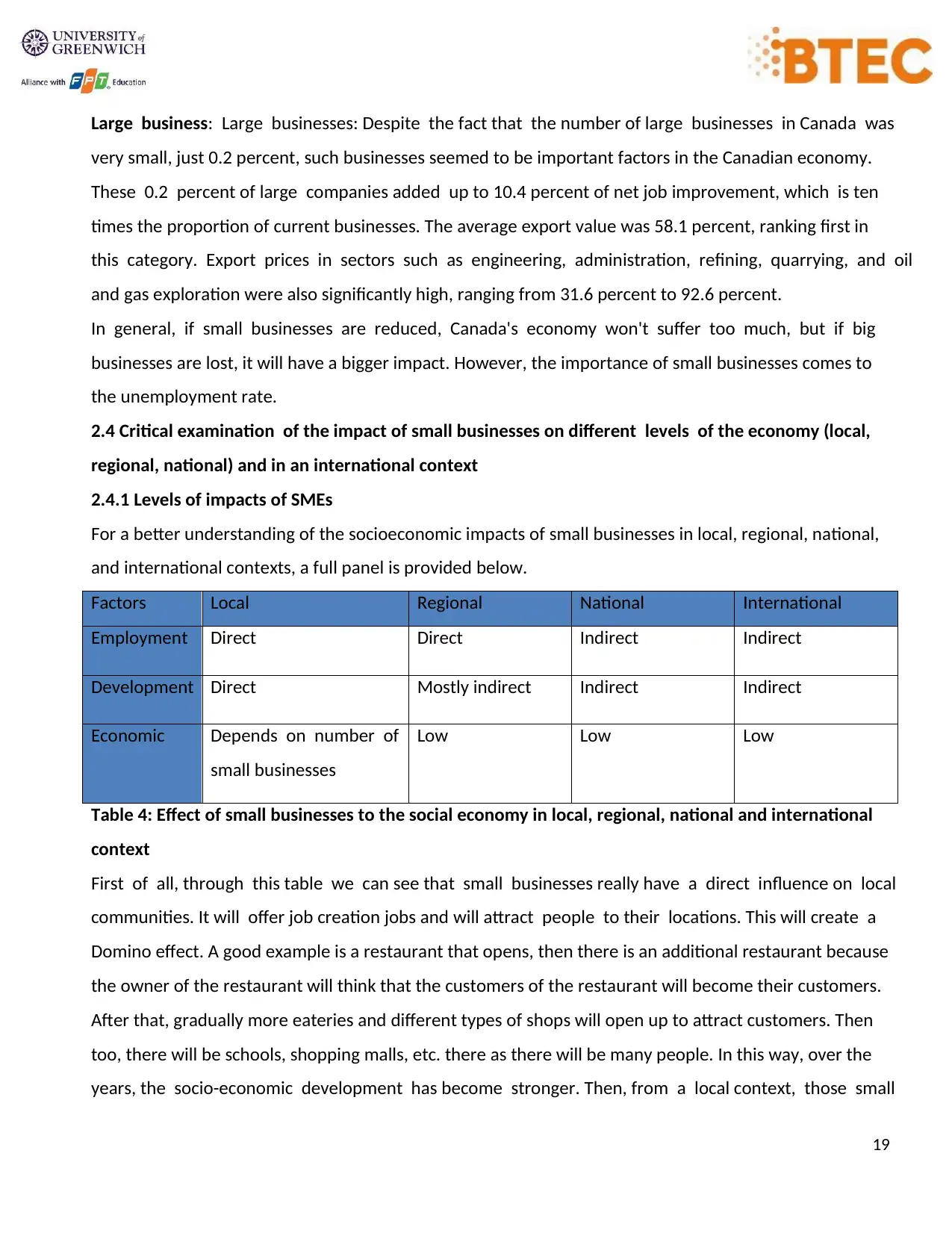
19
Large business: Large businesses: Despite the fact that the number of large businesses in Canada was
very small, just 0.2 percent, such businesses seemed to be important factors in the Canadian economy.
These 0.2 percent of large companies added up to 10.4 percent of net job improvement, which is ten
times the proportion of current businesses. The average export value was 58.1 percent, ranking first in
this category. Export prices in sectors such as engineering, administration, refining, quarrying, and oil
and gas exploration were also significantly high, ranging from 31.6 percent to 92.6 percent.
In general, if small businesses are reduced, Canada's economy won't suffer too much, but if big
businesses are lost, it will have a bigger impact. However, the importance of small businesses comes to
the unemployment rate.
2.4 Critical examination of the impact of small businesses on different levels of the economy (local,
regional, national) and in an international context
2.4.1 Levels of impacts of SMEs
For a better understanding of the socioeconomic impacts of small businesses in local, regional, national,
and international contexts, a full panel is provided below.
Factors Local Regional National International
Employment Direct Direct Indirect Indirect
Development Direct Mostly indirect Indirect Indirect
Economic Depends on number of
small businesses
Low Low Low
Table 4: Effect of small businesses to the social economy in local, regional, national and international
context
First of all, through this table we can see that small businesses really have a direct influence on local
communities. It will offer job creation jobs and will attract people to their locations. This will create a
Domino effect. A good example is a restaurant that opens, then there is an additional restaurant because
the owner of the restaurant will think that the customers of the restaurant will become their customers.
After that, gradually more eateries and different types of shops will open up to attract customers. Then
too, there will be schools, shopping malls, etc. there as there will be many people. In this way, over the
years, the socio-economic development has become stronger. Then, from a local context, those small
Large business: Large businesses: Despite the fact that the number of large businesses in Canada was
very small, just 0.2 percent, such businesses seemed to be important factors in the Canadian economy.
These 0.2 percent of large companies added up to 10.4 percent of net job improvement, which is ten
times the proportion of current businesses. The average export value was 58.1 percent, ranking first in
this category. Export prices in sectors such as engineering, administration, refining, quarrying, and oil
and gas exploration were also significantly high, ranging from 31.6 percent to 92.6 percent.
In general, if small businesses are reduced, Canada's economy won't suffer too much, but if big
businesses are lost, it will have a bigger impact. However, the importance of small businesses comes to
the unemployment rate.
2.4 Critical examination of the impact of small businesses on different levels of the economy (local,
regional, national) and in an international context
2.4.1 Levels of impacts of SMEs
For a better understanding of the socioeconomic impacts of small businesses in local, regional, national,
and international contexts, a full panel is provided below.
Factors Local Regional National International
Employment Direct Direct Indirect Indirect
Development Direct Mostly indirect Indirect Indirect
Economic Depends on number of
small businesses
Low Low Low
Table 4: Effect of small businesses to the social economy in local, regional, national and international
context
First of all, through this table we can see that small businesses really have a direct influence on local
communities. It will offer job creation jobs and will attract people to their locations. This will create a
Domino effect. A good example is a restaurant that opens, then there is an additional restaurant because
the owner of the restaurant will think that the customers of the restaurant will become their customers.
After that, gradually more eateries and different types of shops will open up to attract customers. Then
too, there will be schools, shopping malls, etc. there as there will be many people. In this way, over the
years, the socio-economic development has become stronger. Then, from a local context, those small
Paraphrase This Document
Need a fresh take? Get an instant paraphrase of this document with our AI Paraphraser
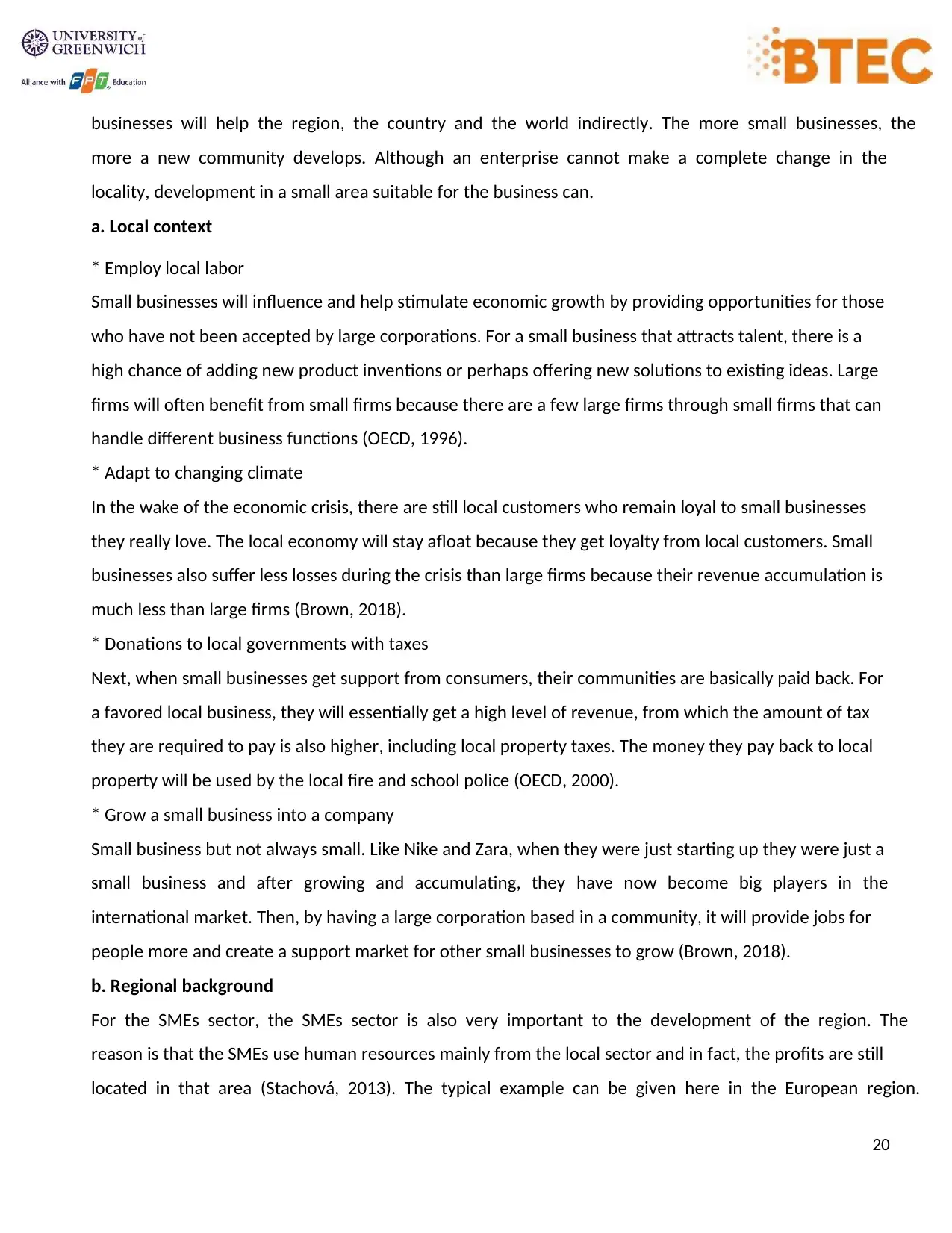
20
businesses will help the region, the country and the world indirectly. The more small businesses, the
more a new community develops. Although an enterprise cannot make a complete change in the
locality, development in a small area suitable for the business can.
a. Local context
* Employ local labor
Small businesses will influence and help stimulate economic growth by providing opportunities for those
who have not been accepted by large corporations. For a small business that attracts talent, there is a
high chance of adding new product inventions or perhaps offering new solutions to existing ideas. Large
firms will often benefit from small firms because there are a few large firms through small firms that can
handle different business functions (OECD, 1996).
* Adapt to changing climate
In the wake of the economic crisis, there are still local customers who remain loyal to small businesses
they really love. The local economy will stay afloat because they get loyalty from local customers. Small
businesses also suffer less losses during the crisis than large firms because their revenue accumulation is
much less than large firms (Brown, 2018).
* Donations to local governments with taxes
Next, when small businesses get support from consumers, their communities are basically paid back. For
a favored local business, they will essentially get a high level of revenue, from which the amount of tax
they are required to pay is also higher, including local property taxes. The money they pay back to local
property will be used by the local fire and school police (OECD, 2000).
* Grow a small business into a company
Small business but not always small. Like Nike and Zara, when they were just starting up they were just a
small business and after growing and accumulating, they have now become big players in the
international market. Then, by having a large corporation based in a community, it will provide jobs for
people more and create a support market for other small businesses to grow (Brown, 2018).
b. Regional background
For the SMEs sector, the SMEs sector is also very important to the development of the region. The
reason is that the SMEs use human resources mainly from the local sector and in fact, the profits are still
located in that area (Stachová, 2013). The typical example can be given here in the European region.
businesses will help the region, the country and the world indirectly. The more small businesses, the
more a new community develops. Although an enterprise cannot make a complete change in the
locality, development in a small area suitable for the business can.
a. Local context
* Employ local labor
Small businesses will influence and help stimulate economic growth by providing opportunities for those
who have not been accepted by large corporations. For a small business that attracts talent, there is a
high chance of adding new product inventions or perhaps offering new solutions to existing ideas. Large
firms will often benefit from small firms because there are a few large firms through small firms that can
handle different business functions (OECD, 1996).
* Adapt to changing climate
In the wake of the economic crisis, there are still local customers who remain loyal to small businesses
they really love. The local economy will stay afloat because they get loyalty from local customers. Small
businesses also suffer less losses during the crisis than large firms because their revenue accumulation is
much less than large firms (Brown, 2018).
* Donations to local governments with taxes
Next, when small businesses get support from consumers, their communities are basically paid back. For
a favored local business, they will essentially get a high level of revenue, from which the amount of tax
they are required to pay is also higher, including local property taxes. The money they pay back to local
property will be used by the local fire and school police (OECD, 2000).
* Grow a small business into a company
Small business but not always small. Like Nike and Zara, when they were just starting up they were just a
small business and after growing and accumulating, they have now become big players in the
international market. Then, by having a large corporation based in a community, it will provide jobs for
people more and create a support market for other small businesses to grow (Brown, 2018).
b. Regional background
For the SMEs sector, the SMEs sector is also very important to the development of the region. The
reason is that the SMEs use human resources mainly from the local sector and in fact, the profits are still
located in that area (Stachová, 2013). The typical example can be given here in the European region.
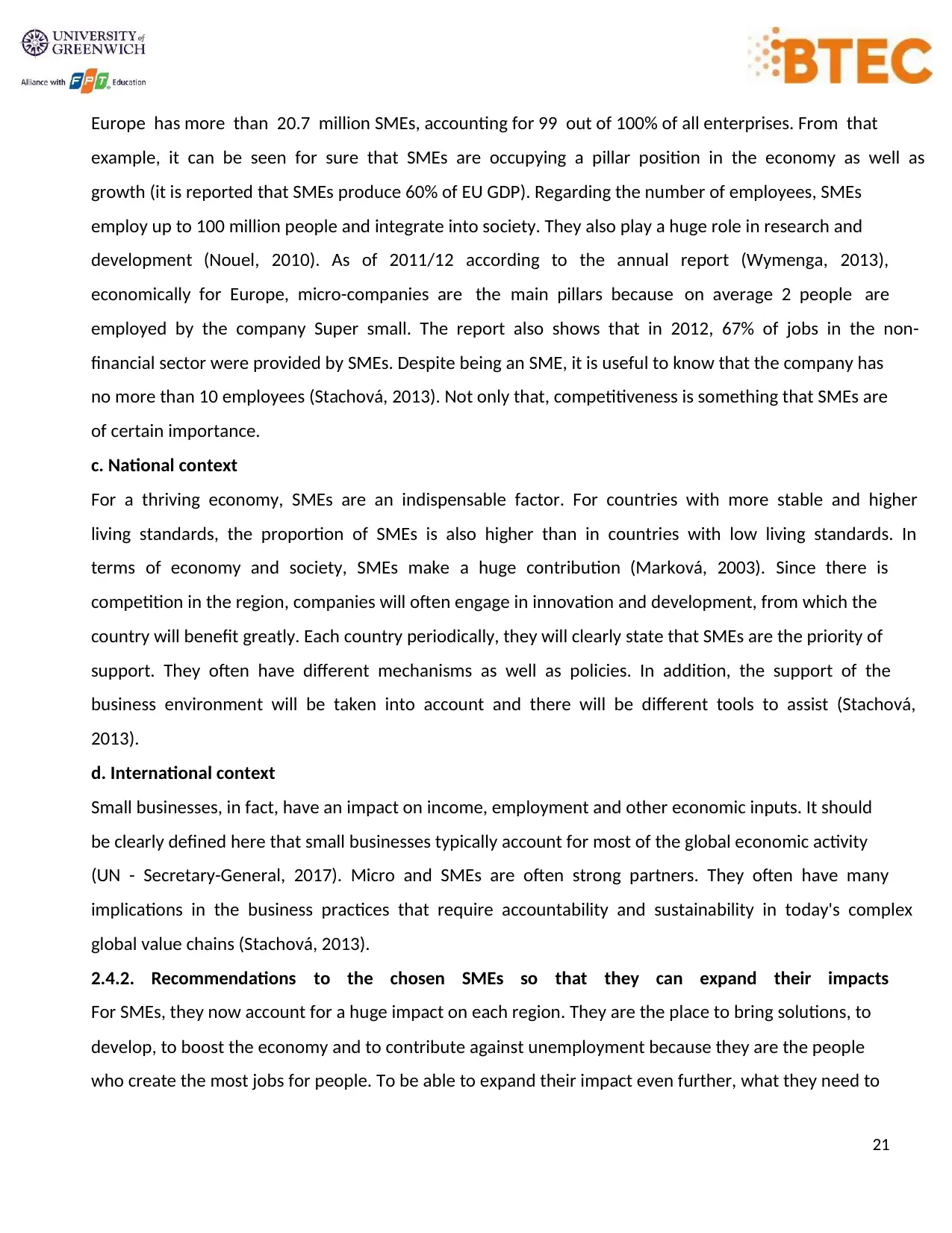
21
Europe has more than 20.7 million SMEs, accounting for 99 out of 100% of all enterprises. From that
example, it can be seen for sure that SMEs are occupying a pillar position in the economy as well as
growth (it is reported that SMEs produce 60% of EU GDP). Regarding the number of employees, SMEs
employ up to 100 million people and integrate into society. They also play a huge role in research and
development (Nouel, 2010). As of 2011/12 according to the annual report (Wymenga, 2013),
economically for Europe, micro-companies are the main pillars because on average 2 people are
employed by the company Super small. The report also shows that in 2012, 67% of jobs in the non-
financial sector were provided by SMEs. Despite being an SME, it is useful to know that the company has
no more than 10 employees (Stachová, 2013). Not only that, competitiveness is something that SMEs are
of certain importance.
c. National context
For a thriving economy, SMEs are an indispensable factor. For countries with more stable and higher
living standards, the proportion of SMEs is also higher than in countries with low living standards. In
terms of economy and society, SMEs make a huge contribution (Marková, 2003). Since there is
competition in the region, companies will often engage in innovation and development, from which the
country will benefit greatly. Each country periodically, they will clearly state that SMEs are the priority of
support. They often have different mechanisms as well as policies. In addition, the support of the
business environment will be taken into account and there will be different tools to assist (Stachová,
2013).
d. International context
Small businesses, in fact, have an impact on income, employment and other economic inputs. It should
be clearly defined here that small businesses typically account for most of the global economic activity
(UN - Secretary-General, 2017). Micro and SMEs are often strong partners. They often have many
implications in the business practices that require accountability and sustainability in today's complex
global value chains (Stachová, 2013).
2.4.2. Recommendations to the chosen SMEs so that they can expand their impacts
For SMEs, they now account for a huge impact on each region. They are the place to bring solutions, to
develop, to boost the economy and to contribute against unemployment because they are the people
who create the most jobs for people. To be able to expand their impact even further, what they need to
Europe has more than 20.7 million SMEs, accounting for 99 out of 100% of all enterprises. From that
example, it can be seen for sure that SMEs are occupying a pillar position in the economy as well as
growth (it is reported that SMEs produce 60% of EU GDP). Regarding the number of employees, SMEs
employ up to 100 million people and integrate into society. They also play a huge role in research and
development (Nouel, 2010). As of 2011/12 according to the annual report (Wymenga, 2013),
economically for Europe, micro-companies are the main pillars because on average 2 people are
employed by the company Super small. The report also shows that in 2012, 67% of jobs in the non-
financial sector were provided by SMEs. Despite being an SME, it is useful to know that the company has
no more than 10 employees (Stachová, 2013). Not only that, competitiveness is something that SMEs are
of certain importance.
c. National context
For a thriving economy, SMEs are an indispensable factor. For countries with more stable and higher
living standards, the proportion of SMEs is also higher than in countries with low living standards. In
terms of economy and society, SMEs make a huge contribution (Marková, 2003). Since there is
competition in the region, companies will often engage in innovation and development, from which the
country will benefit greatly. Each country periodically, they will clearly state that SMEs are the priority of
support. They often have different mechanisms as well as policies. In addition, the support of the
business environment will be taken into account and there will be different tools to assist (Stachová,
2013).
d. International context
Small businesses, in fact, have an impact on income, employment and other economic inputs. It should
be clearly defined here that small businesses typically account for most of the global economic activity
(UN - Secretary-General, 2017). Micro and SMEs are often strong partners. They often have many
implications in the business practices that require accountability and sustainability in today's complex
global value chains (Stachová, 2013).
2.4.2. Recommendations to the chosen SMEs so that they can expand their impacts
For SMEs, they now account for a huge impact on each region. They are the place to bring solutions, to
develop, to boost the economy and to contribute against unemployment because they are the people
who create the most jobs for people. To be able to expand their impact even further, what they need to

22
do is continue to come up with solutions to accelerate their growth that can demonstrate their
importance to each region. In addition, they also contribute to combat unemployment in the present
time. Especially when the COVID epidemic was taking place in countries around the world, when
everyone was unemployed. If they can keep the company stable and can bring in more people so that
everyone has a job, their impact on each area will be extremely high. Moreover, SMEs need improve the
institutional framework and operational environment. Building on the progress made in the general
business environment and the recent institutional developments to support small and medium-sized
enterprises, further reforms should be considered to ensure the policy-making process is specific to
SMEs and that the operational environment evolves in an SME-friendly way. Market research and
development: analysis of demand trends for export products, dissemination of target market intelligence
and help in designing market-entry strategies. Trade information provision: on importers, prices, export
procedures, standards, quality and documentation requirements in target markets. Promote skills
development and entrepreneurial culture. Support SMEs’ internationalization and facilitate SMEs’
innovation.
CONCLUSION
In general, through this report has made many real differences in the impact of businesses as well as
small businesses on the economy. Through examples as well as definitions, the types of joint ventures
have been clearly explained. Business impacts for small businesses are regional, regional, and national.
Thereby, it is clear that small businesses not only affect local but also regional and national. Through this
report, people will have a clearer perspective on startups as well as small businesses and they can apply
the amount of knowledge to have a foundation as well as easier to develop at work. The most important
thing is advice about the government, the government should also help as well as facilitate small
businesses to move out of the regional framework.
do is continue to come up with solutions to accelerate their growth that can demonstrate their
importance to each region. In addition, they also contribute to combat unemployment in the present
time. Especially when the COVID epidemic was taking place in countries around the world, when
everyone was unemployed. If they can keep the company stable and can bring in more people so that
everyone has a job, their impact on each area will be extremely high. Moreover, SMEs need improve the
institutional framework and operational environment. Building on the progress made in the general
business environment and the recent institutional developments to support small and medium-sized
enterprises, further reforms should be considered to ensure the policy-making process is specific to
SMEs and that the operational environment evolves in an SME-friendly way. Market research and
development: analysis of demand trends for export products, dissemination of target market intelligence
and help in designing market-entry strategies. Trade information provision: on importers, prices, export
procedures, standards, quality and documentation requirements in target markets. Promote skills
development and entrepreneurial culture. Support SMEs’ internationalization and facilitate SMEs’
innovation.
CONCLUSION
In general, through this report has made many real differences in the impact of businesses as well as
small businesses on the economy. Through examples as well as definitions, the types of joint ventures
have been clearly explained. Business impacts for small businesses are regional, regional, and national.
Thereby, it is clear that small businesses not only affect local but also regional and national. Through this
report, people will have a clearer perspective on startups as well as small businesses and they can apply
the amount of knowledge to have a foundation as well as easier to develop at work. The most important
thing is advice about the government, the government should also help as well as facilitate small
businesses to move out of the regional framework.
Secure Best Marks with AI Grader
Need help grading? Try our AI Grader for instant feedback on your assignments.
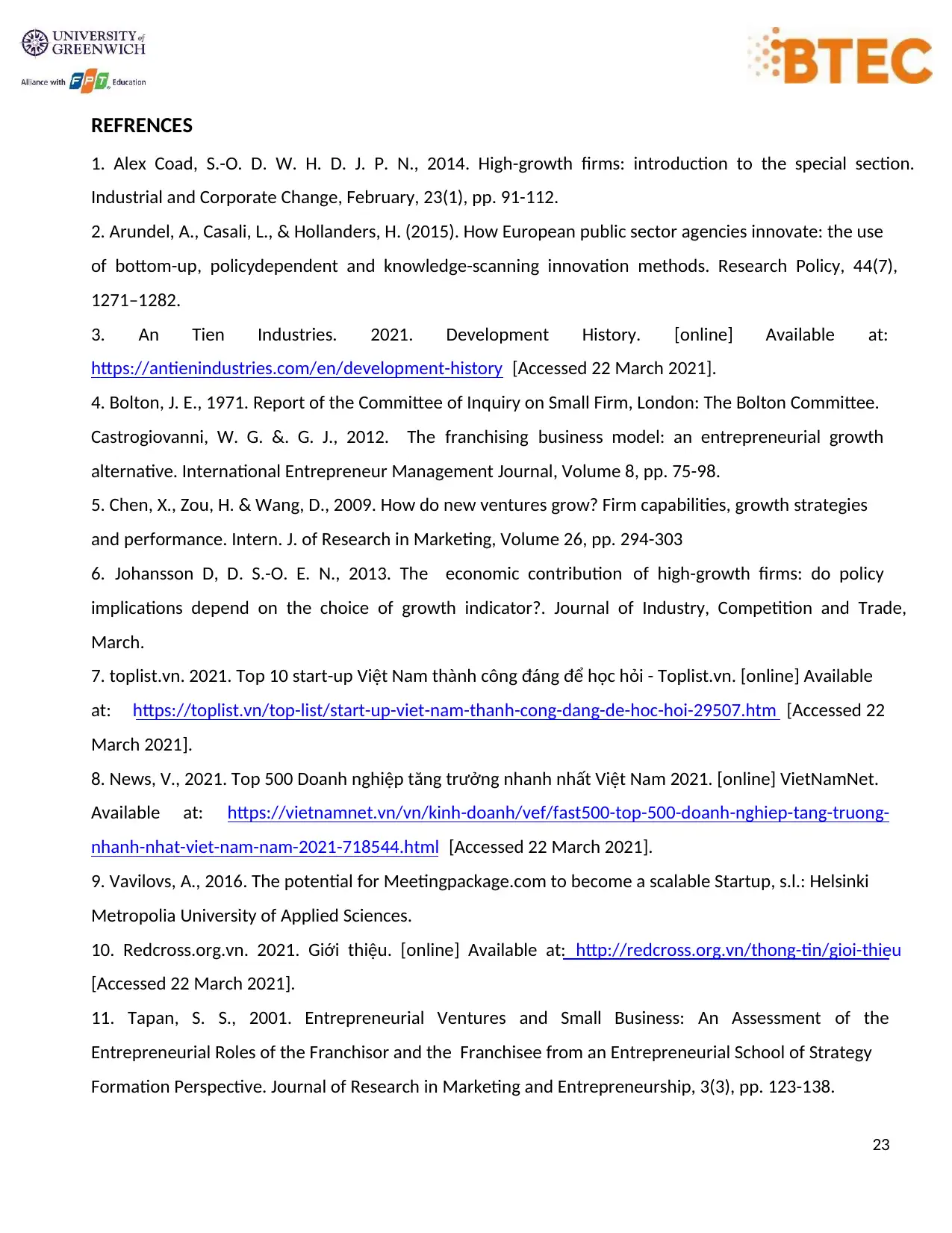
23
REFRENCES
1. Alex Coad, S.-O. D. W. H. D. J. P. N., 2014. High-growth firms: introduction to the special section.
Industrial and Corporate Change, February, 23(1), pp. 91-112.
2. Arundel, A., Casali, L., & Hollanders, H. (2015). How European public sector agencies innovate: the use
of bottom-up, policydependent and knowledge-scanning innovation methods. Research Policy, 44(7),
1271–1282.
3. An Tien Industries. 2021. Development History. [online] Available at:
https://antienindustries.com/en/development-history [Accessed 22 March 2021].
4. Bolton, J. E., 1971. Report of the Committee of Inquiry on Small Firm, London: The Bolton Committee.
Castrogiovanni, W. G. &. G. J., 2012. The franchising business model: an entrepreneurial growth
alternative. International Entrepreneur Management Journal, Volume 8, pp. 75-98.
5. Chen, X., Zou, H. & Wang, D., 2009. How do new ventures grow? Firm capabilities, growth strategies
and performance. Intern. J. of Research in Marketing, Volume 26, pp. 294-303
6. Johansson D, D. S.-O. E. N., 2013. The economic contribution of high-growth firms: do policy
implications depend on the choice of growth indicator?. Journal of Industry, Competition and Trade,
March.
7. toplist.vn. 2021. Top 10 start-up Việt Nam thành công đáng để học hỏi - Toplist.vn. [online] Available
at: https://toplist.vn/top-list/start-up-viet-nam-thanh-cong-dang-de-hoc-hoi-29507.htm [Accessed 22
March 2021].
8. News, V., 2021. Top 500 Doanh nghiệp tăng trưởng nhanh nhất Việt Nam 2021. [online] VietNamNet.
Available at: https://vietnamnet.vn/vn/kinh-doanh/vef/fast500-top-500-doanh-nghiep-tang-truong-
nhanh-nhat-viet-nam-nam-2021-718544.html [Accessed 22 March 2021].
9. Vavilovs, A., 2016. The potential for Meetingpackage.com to become a scalable Startup, s.l.: Helsinki
Metropolia University of Applied Sciences.
10. Redcross.org.vn. 2021. Giới thiệu. [online] Available at: http://redcross.org.vn/thong-tin/gioi-thieu
[Accessed 22 March 2021].
11. Tapan, S. S., 2001. Entrepreneurial Ventures and Small Business: An Assessment of the
Entrepreneurial Roles of the Franchisor and the Franchisee from an Entrepreneurial School of Strategy
Formation Perspective. Journal of Research in Marketing and Entrepreneurship, 3(3), pp. 123-138.
REFRENCES
1. Alex Coad, S.-O. D. W. H. D. J. P. N., 2014. High-growth firms: introduction to the special section.
Industrial and Corporate Change, February, 23(1), pp. 91-112.
2. Arundel, A., Casali, L., & Hollanders, H. (2015). How European public sector agencies innovate: the use
of bottom-up, policydependent and knowledge-scanning innovation methods. Research Policy, 44(7),
1271–1282.
3. An Tien Industries. 2021. Development History. [online] Available at:
https://antienindustries.com/en/development-history [Accessed 22 March 2021].
4. Bolton, J. E., 1971. Report of the Committee of Inquiry on Small Firm, London: The Bolton Committee.
Castrogiovanni, W. G. &. G. J., 2012. The franchising business model: an entrepreneurial growth
alternative. International Entrepreneur Management Journal, Volume 8, pp. 75-98.
5. Chen, X., Zou, H. & Wang, D., 2009. How do new ventures grow? Firm capabilities, growth strategies
and performance. Intern. J. of Research in Marketing, Volume 26, pp. 294-303
6. Johansson D, D. S.-O. E. N., 2013. The economic contribution of high-growth firms: do policy
implications depend on the choice of growth indicator?. Journal of Industry, Competition and Trade,
March.
7. toplist.vn. 2021. Top 10 start-up Việt Nam thành công đáng để học hỏi - Toplist.vn. [online] Available
at: https://toplist.vn/top-list/start-up-viet-nam-thanh-cong-dang-de-hoc-hoi-29507.htm [Accessed 22
March 2021].
8. News, V., 2021. Top 500 Doanh nghiệp tăng trưởng nhanh nhất Việt Nam 2021. [online] VietNamNet.
Available at: https://vietnamnet.vn/vn/kinh-doanh/vef/fast500-top-500-doanh-nghiep-tang-truong-
nhanh-nhat-viet-nam-nam-2021-718544.html [Accessed 22 March 2021].
9. Vavilovs, A., 2016. The potential for Meetingpackage.com to become a scalable Startup, s.l.: Helsinki
Metropolia University of Applied Sciences.
10. Redcross.org.vn. 2021. Giới thiệu. [online] Available at: http://redcross.org.vn/thong-tin/gioi-thieu
[Accessed 22 March 2021].
11. Tapan, S. S., 2001. Entrepreneurial Ventures and Small Business: An Assessment of the
Entrepreneurial Roles of the Franchisor and the Franchisee from an Entrepreneurial School of Strategy
Formation Perspective. Journal of Research in Marketing and Entrepreneurship, 3(3), pp. 123-138.
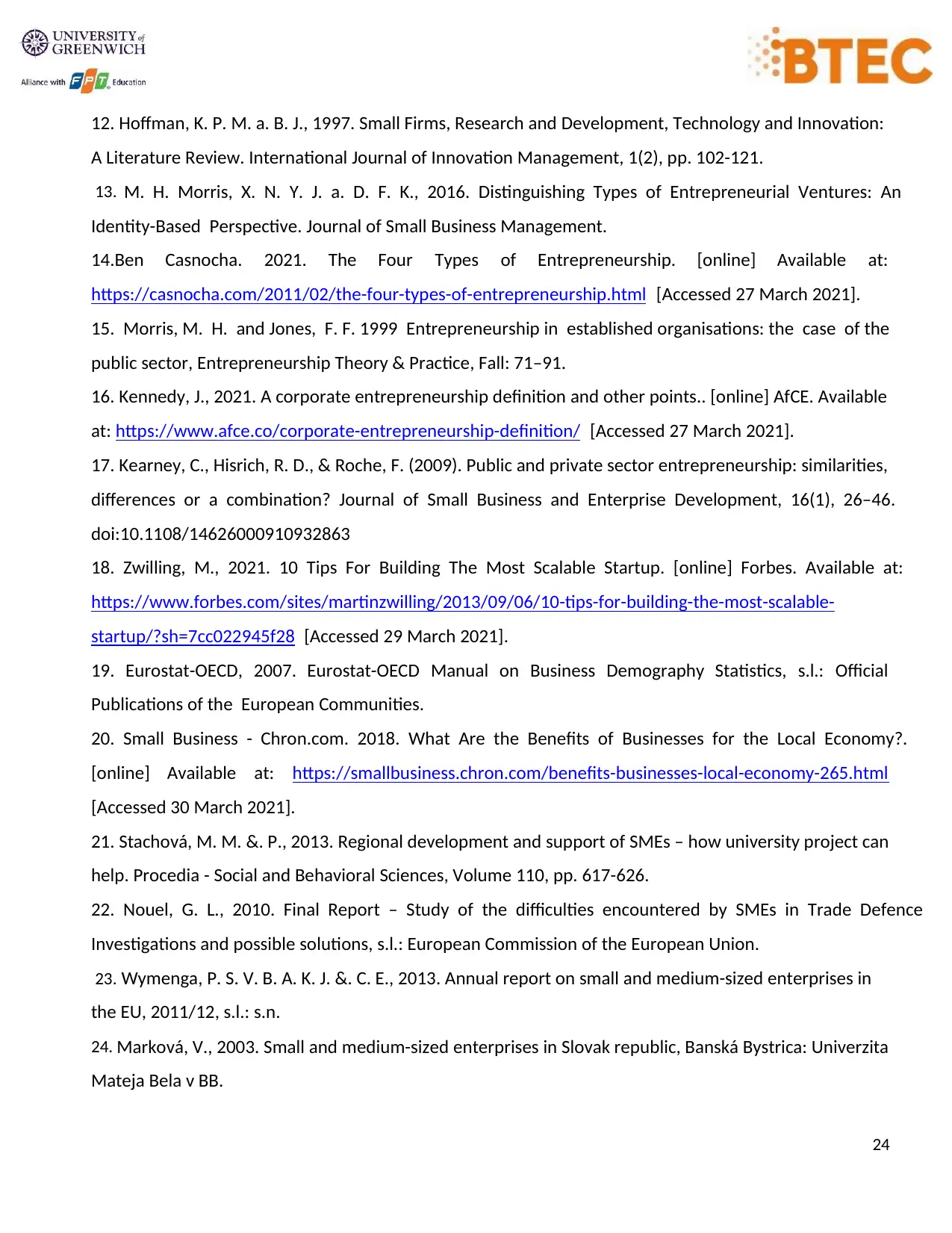
24
12. Hoffman, K. P. M. a. B. J., 1997. Small Firms, Research and Development, Technology and Innovation:
A Literature Review. International Journal of Innovation Management, 1(2), pp. 102-121.
13. M. H. Morris, X. N. Y. J. a. D. F. K., 2016. Distinguishing Types of Entrepreneurial Ventures: An
Identity-Based Perspective. Journal of Small Business Management.
14.Ben Casnocha. 2021. The Four Types of Entrepreneurship. [online] Available at:
https://casnocha.com/2011/02/the-four-types-of-entrepreneurship.html [Accessed 27 March 2021].
15. Morris, M. H. and Jones, F. F. 1999 Entrepreneurship in established organisations: the case of the
public sector, Entrepreneurship Theory & Practice, Fall: 71–91.
16. Kennedy, J., 2021. A corporate entrepreneurship definition and other points.. [online] AfCE. Available
at: https://www.afce.co/corporate-entrepreneurship-definition/ [Accessed 27 March 2021].
17. Kearney, C., Hisrich, R. D., & Roche, F. (2009). Public and private sector entrepreneurship: similarities,
differences or a combination? Journal of Small Business and Enterprise Development, 16(1), 26–46.
doi:10.1108/14626000910932863
18. Zwilling, M., 2021. 10 Tips For Building The Most Scalable Startup. [online] Forbes. Available at:
https://www.forbes.com/sites/martinzwilling/2013/09/06/10-tips-for-building-the-most-scalable-
startup/?sh=7cc022945f28 [Accessed 29 March 2021].
19. Eurostat-OECD, 2007. Eurostat-OECD Manual on Business Demography Statistics, s.l.: Official
Publications of the European Communities.
20. Small Business - Chron.com. 2018. What Are the Benefits of Businesses for the Local Economy?.
[online] Available at: https://smallbusiness.chron.com/benefits-businesses-local-economy-265.html
[Accessed 30 March 2021].
21. Stachová, M. M. &. P., 2013. Regional development and support of SMEs – how university project can
help. Procedia - Social and Behavioral Sciences, Volume 110, pp. 617-626.
22. Nouel, G. L., 2010. Final Report – Study of the difficulties encountered by SMEs in Trade Defence
Investigations and possible solutions, s.l.: European Commission of the European Union.
23. Wymenga, P. S. V. B. A. K. J. &. C. E., 2013. Annual report on small and medium-sized enterprises in
the EU, 2011/12, s.l.: s.n.
24. Marková, V., 2003. Small and medium-sized enterprises in Slovak republic, Banská Bystrica: Univerzita
Mateja Bela v BB.
12. Hoffman, K. P. M. a. B. J., 1997. Small Firms, Research and Development, Technology and Innovation:
A Literature Review. International Journal of Innovation Management, 1(2), pp. 102-121.
13. M. H. Morris, X. N. Y. J. a. D. F. K., 2016. Distinguishing Types of Entrepreneurial Ventures: An
Identity-Based Perspective. Journal of Small Business Management.
14.Ben Casnocha. 2021. The Four Types of Entrepreneurship. [online] Available at:
https://casnocha.com/2011/02/the-four-types-of-entrepreneurship.html [Accessed 27 March 2021].
15. Morris, M. H. and Jones, F. F. 1999 Entrepreneurship in established organisations: the case of the
public sector, Entrepreneurship Theory & Practice, Fall: 71–91.
16. Kennedy, J., 2021. A corporate entrepreneurship definition and other points.. [online] AfCE. Available
at: https://www.afce.co/corporate-entrepreneurship-definition/ [Accessed 27 March 2021].
17. Kearney, C., Hisrich, R. D., & Roche, F. (2009). Public and private sector entrepreneurship: similarities,
differences or a combination? Journal of Small Business and Enterprise Development, 16(1), 26–46.
doi:10.1108/14626000910932863
18. Zwilling, M., 2021. 10 Tips For Building The Most Scalable Startup. [online] Forbes. Available at:
https://www.forbes.com/sites/martinzwilling/2013/09/06/10-tips-for-building-the-most-scalable-
startup/?sh=7cc022945f28 [Accessed 29 March 2021].
19. Eurostat-OECD, 2007. Eurostat-OECD Manual on Business Demography Statistics, s.l.: Official
Publications of the European Communities.
20. Small Business - Chron.com. 2018. What Are the Benefits of Businesses for the Local Economy?.
[online] Available at: https://smallbusiness.chron.com/benefits-businesses-local-economy-265.html
[Accessed 30 March 2021].
21. Stachová, M. M. &. P., 2013. Regional development and support of SMEs – how university project can
help. Procedia - Social and Behavioral Sciences, Volume 110, pp. 617-626.
22. Nouel, G. L., 2010. Final Report – Study of the difficulties encountered by SMEs in Trade Defence
Investigations and possible solutions, s.l.: European Commission of the European Union.
23. Wymenga, P. S. V. B. A. K. J. &. C. E., 2013. Annual report on small and medium-sized enterprises in
the EU, 2011/12, s.l.: s.n.
24. Marková, V., 2003. Small and medium-sized enterprises in Slovak republic, Banská Bystrica: Univerzita
Mateja Bela v BB.
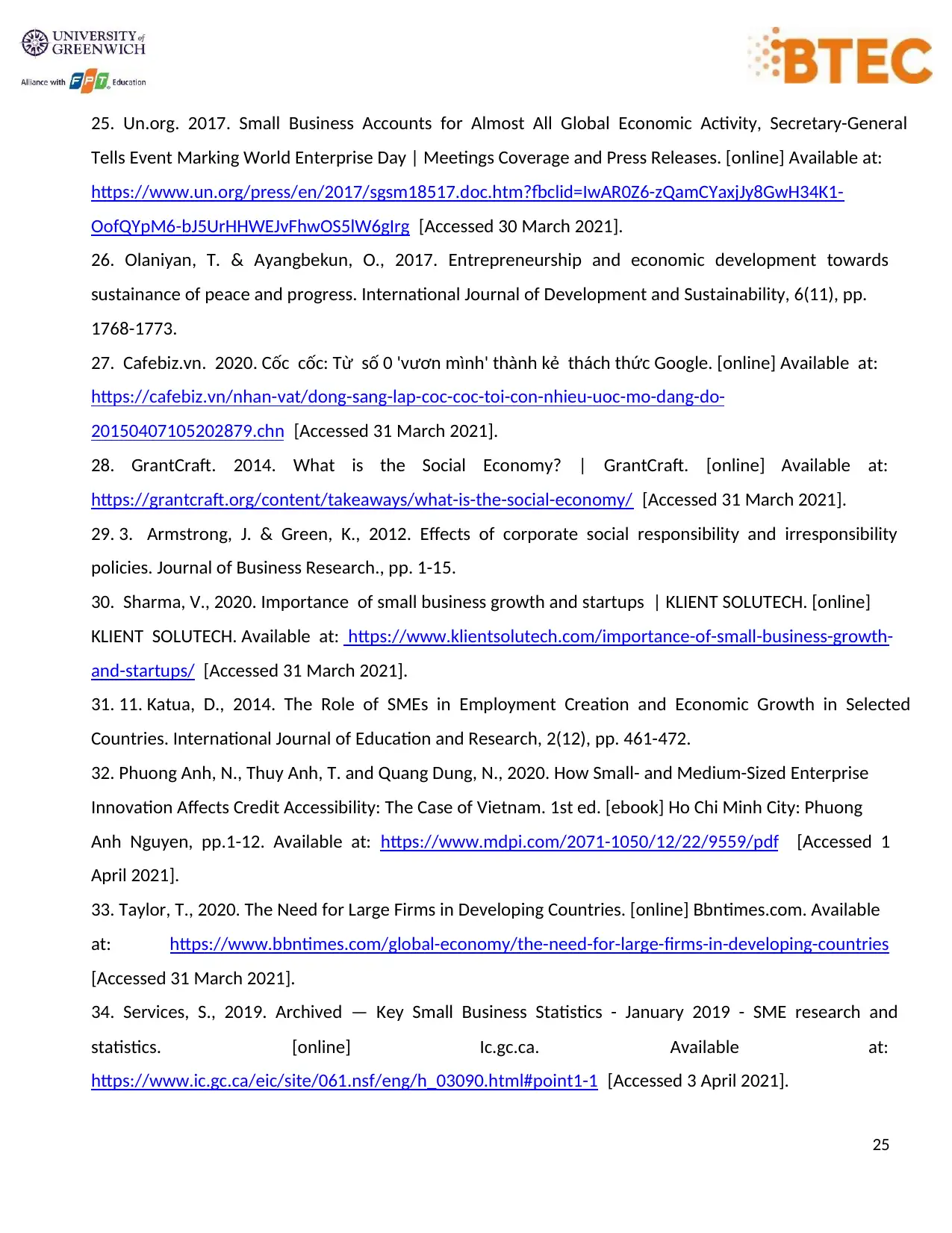
25
25. Un.org. 2017. Small Business Accounts for Almost All Global Economic Activity, Secretary-General
Tells Event Marking World Enterprise Day | Meetings Coverage and Press Releases. [online] Available at:
https://www.un.org/press/en/2017/sgsm18517.doc.htm?fbclid=IwAR0Z6-zQamCYaxjJy8GwH34K1-
OofQYpM6-bJ5UrHHWEJvFhwOS5lW6gIrg [Accessed 30 March 2021].
26. Olaniyan, T. & Ayangbekun, O., 2017. Entrepreneurship and economic development towards
sustainance of peace and progress. International Journal of Development and Sustainability, 6(11), pp.
1768-1773.
27. Cafebiz.vn. 2020. Cốc cốc: Từ số 0 'vươn mình' thành kẻ thách thức Google. [online] Available at:
https://cafebiz.vn/nhan-vat/dong-sang-lap-coc-coc-toi-con-nhieu-uoc-mo-dang-do-
20150407105202879.chn [Accessed 31 March 2021].
28. GrantCraft. 2014. What is the Social Economy? | GrantCraft. [online] Available at:
https://grantcraft.org/content/takeaways/what-is-the-social-economy/ [Accessed 31 March 2021].
29. 3. Armstrong, J. & Green, K., 2012. Effects of corporate social responsibility and irresponsibility
policies. Journal of Business Research., pp. 1-15.
30. Sharma, V., 2020. Importance of small business growth and startups | KLIENT SOLUTECH. [online]
KLIENT SOLUTECH. Available at: https://www.klientsolutech.com/importance-of-small-business-growth-
and-startups/ [Accessed 31 March 2021].
31. 11. Katua, D., 2014. The Role of SMEs in Employment Creation and Economic Growth in Selected
Countries. International Journal of Education and Research, 2(12), pp. 461-472.
32. Phuong Anh, N., Thuy Anh, T. and Quang Dung, N., 2020. How Small- and Medium-Sized Enterprise
Innovation Affects Credit Accessibility: The Case of Vietnam. 1st ed. [ebook] Ho Chi Minh City: Phuong
Anh Nguyen, pp.1-12. Available at: https://www.mdpi.com/2071-1050/12/22/9559/pdf [Accessed 1
April 2021].
33. Taylor, T., 2020. The Need for Large Firms in Developing Countries. [online] Bbntimes.com. Available
at: https://www.bbntimes.com/global-economy/the-need-for-large-firms-in-developing-countries
[Accessed 31 March 2021].
34. Services, S., 2019. Archived — Key Small Business Statistics - January 2019 - SME research and
statistics. [online] Ic.gc.ca. Available at:
https://www.ic.gc.ca/eic/site/061.nsf/eng/h_03090.html#point1-1 [Accessed 3 April 2021].
25. Un.org. 2017. Small Business Accounts for Almost All Global Economic Activity, Secretary-General
Tells Event Marking World Enterprise Day | Meetings Coverage and Press Releases. [online] Available at:
https://www.un.org/press/en/2017/sgsm18517.doc.htm?fbclid=IwAR0Z6-zQamCYaxjJy8GwH34K1-
OofQYpM6-bJ5UrHHWEJvFhwOS5lW6gIrg [Accessed 30 March 2021].
26. Olaniyan, T. & Ayangbekun, O., 2017. Entrepreneurship and economic development towards
sustainance of peace and progress. International Journal of Development and Sustainability, 6(11), pp.
1768-1773.
27. Cafebiz.vn. 2020. Cốc cốc: Từ số 0 'vươn mình' thành kẻ thách thức Google. [online] Available at:
https://cafebiz.vn/nhan-vat/dong-sang-lap-coc-coc-toi-con-nhieu-uoc-mo-dang-do-
20150407105202879.chn [Accessed 31 March 2021].
28. GrantCraft. 2014. What is the Social Economy? | GrantCraft. [online] Available at:
https://grantcraft.org/content/takeaways/what-is-the-social-economy/ [Accessed 31 March 2021].
29. 3. Armstrong, J. & Green, K., 2012. Effects of corporate social responsibility and irresponsibility
policies. Journal of Business Research., pp. 1-15.
30. Sharma, V., 2020. Importance of small business growth and startups | KLIENT SOLUTECH. [online]
KLIENT SOLUTECH. Available at: https://www.klientsolutech.com/importance-of-small-business-growth-
and-startups/ [Accessed 31 March 2021].
31. 11. Katua, D., 2014. The Role of SMEs in Employment Creation and Economic Growth in Selected
Countries. International Journal of Education and Research, 2(12), pp. 461-472.
32. Phuong Anh, N., Thuy Anh, T. and Quang Dung, N., 2020. How Small- and Medium-Sized Enterprise
Innovation Affects Credit Accessibility: The Case of Vietnam. 1st ed. [ebook] Ho Chi Minh City: Phuong
Anh Nguyen, pp.1-12. Available at: https://www.mdpi.com/2071-1050/12/22/9559/pdf [Accessed 1
April 2021].
33. Taylor, T., 2020. The Need for Large Firms in Developing Countries. [online] Bbntimes.com. Available
at: https://www.bbntimes.com/global-economy/the-need-for-large-firms-in-developing-countries
[Accessed 31 March 2021].
34. Services, S., 2019. Archived — Key Small Business Statistics - January 2019 - SME research and
statistics. [online] Ic.gc.ca. Available at:
https://www.ic.gc.ca/eic/site/061.nsf/eng/h_03090.html#point1-1 [Accessed 3 April 2021].
Paraphrase This Document
Need a fresh take? Get an instant paraphrase of this document with our AI Paraphraser

26
35. BDC.ca. n.d. 4 ways innovation can help your business | BDC.ca. [online] Available at:
https://www.bdc.ca/en/articles-tools/business-strategy-planning/innovate/4-ways-innovation-can-help-
your-business [Accessed 3 April 2021].
Powered by TCPDF (www.tcpdf.org)
35. BDC.ca. n.d. 4 ways innovation can help your business | BDC.ca. [online] Available at:
https://www.bdc.ca/en/articles-tools/business-strategy-planning/innovate/4-ways-innovation-can-help-
your-business [Accessed 3 April 2021].
Powered by TCPDF (www.tcpdf.org)

Index of comments
2.1 Student provided definition of each type of entrepreneurial ventures and has given an example of each type and
how they relate to the typology of entrepreneurship. Good choice of example businesses (P1 achieved)
Student analyzed similarities and differences between entrepreneurial ventures by addressing criteria such as
market goals, structure and employees number (P2 achieved)
Entrepreneurship in the public and corporate sector were analyzed, showing the differences in ownership, roles and
critical points of comparison have been provided (M1 achieved)
Recommendations have been given based on a good analysis of key success factors for the scope, development
and growth of entrepreneurial ventures (D1 achieved)
Student analyzed the impact of small businesses on the economy using statistics and data from the Vietnamese
economy as well as giving example of the chosen small business “Hai Anh coffee shop” (P3 achieved)
Student provided definition of social economy and also highlighted the importance of small businesses and start-
ups to the social economy and gave example of the chosen small business “Hai Anh coffee shop” (P4 achieved)
Good analysis of the differences small, medium and large businesses make to the economy in terms of export
value, employment and GDP contribution (M2 achieved)
Good analysis of the impact of small businesses on different levels of the economy comparing data and statistics
from Vietnam and different countries as well as a recommendation for small businesses on how to increase their
impact (D2 achieved)
Improvement:
Very good effort and well-written assignment
The chosen social enterprise could be included as example on how organizations benefit the social economy
The impact on social economy could be more specific to aspects of charities and environmental initiatives
Final Grade: P1, P2, P3, P4, M1, M2, D1, D2
Assessor name: Badr Badraoui
Powered by TCPDF (www.tcpdf.org)
2.1 Student provided definition of each type of entrepreneurial ventures and has given an example of each type and
how they relate to the typology of entrepreneurship. Good choice of example businesses (P1 achieved)
Student analyzed similarities and differences between entrepreneurial ventures by addressing criteria such as
market goals, structure and employees number (P2 achieved)
Entrepreneurship in the public and corporate sector were analyzed, showing the differences in ownership, roles and
critical points of comparison have been provided (M1 achieved)
Recommendations have been given based on a good analysis of key success factors for the scope, development
and growth of entrepreneurial ventures (D1 achieved)
Student analyzed the impact of small businesses on the economy using statistics and data from the Vietnamese
economy as well as giving example of the chosen small business “Hai Anh coffee shop” (P3 achieved)
Student provided definition of social economy and also highlighted the importance of small businesses and start-
ups to the social economy and gave example of the chosen small business “Hai Anh coffee shop” (P4 achieved)
Good analysis of the differences small, medium and large businesses make to the economy in terms of export
value, employment and GDP contribution (M2 achieved)
Good analysis of the impact of small businesses on different levels of the economy comparing data and statistics
from Vietnam and different countries as well as a recommendation for small businesses on how to increase their
impact (D2 achieved)
Improvement:
Very good effort and well-written assignment
The chosen social enterprise could be included as example on how organizations benefit the social economy
The impact on social economy could be more specific to aspects of charities and environmental initiatives
Final Grade: P1, P2, P3, P4, M1, M2, D1, D2
Assessor name: Badr Badraoui
Powered by TCPDF (www.tcpdf.org)
1 out of 27
Related Documents
Your All-in-One AI-Powered Toolkit for Academic Success.
+13062052269
info@desklib.com
Available 24*7 on WhatsApp / Email
![[object Object]](/_next/static/media/star-bottom.7253800d.svg)
Unlock your academic potential
© 2024 | Zucol Services PVT LTD | All rights reserved.





